Archived Water Damage Blog Posts
The Role of Dehumidifiers in Water Damage Restoration
12/18/2024 (Permalink)
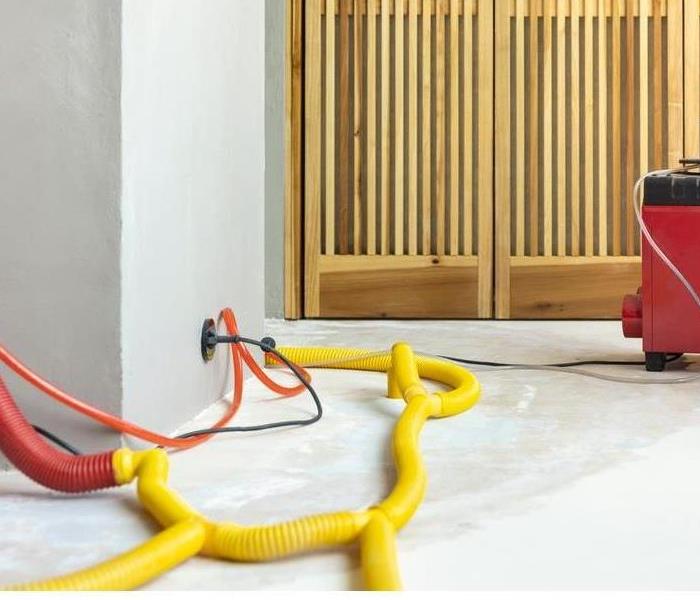 Dehumidifiers make water damage restoration easier - while also minimizing the odds of mold growth!
Dehumidifiers make water damage restoration easier - while also minimizing the odds of mold growth!
Water damage can snowball into a much bigger issue if not handled quickly. That’s why people often resort to calling a professional restoration company to handle the damage. A common tool they bring with them is a dehumidifier. We’ll go over their use during this process below:
They Eliminate Excess Moisture
Water damage causes moisture to get trapped in walls, floors, and furniture. So, besides removing excess moisture from the air, dehumidifiers also keep these surfaces moisture-free.
They Prevent Structural Damage
When water seeps into deep corners of your home, it weakens the wood, drywall, and other building materials. In the end, this greatly affects the structural integrity of your home. Using a dehumidifier during this process helps prevent these problems.
They Prevent Mold Growth
Mold growth is a natural consequence of damp environments. Dehumidifiers help to keep a dry environment to prevent mold from multiplying.
They Accelerate Recovery
The faster you handle water damage, the better it is for your property. Dehumidifiers make that possible, which reduces the time required for repairs.
Water Damage Restoration With SERVPRO
Water damage can devastate a property, which is why it’s crucial to act quickly. SERVPRO of East Boston, Chelsea, & Revere will ensure that your property makes a complete recovery. We’ll use dehumidifiers and other tools to clean your property, remove moisture, and ensure that your space gets a hard reset. Give us a call 24/7 for immediate assistance!
How To Prevent Ice Dams
10/31/2024 (Permalink)
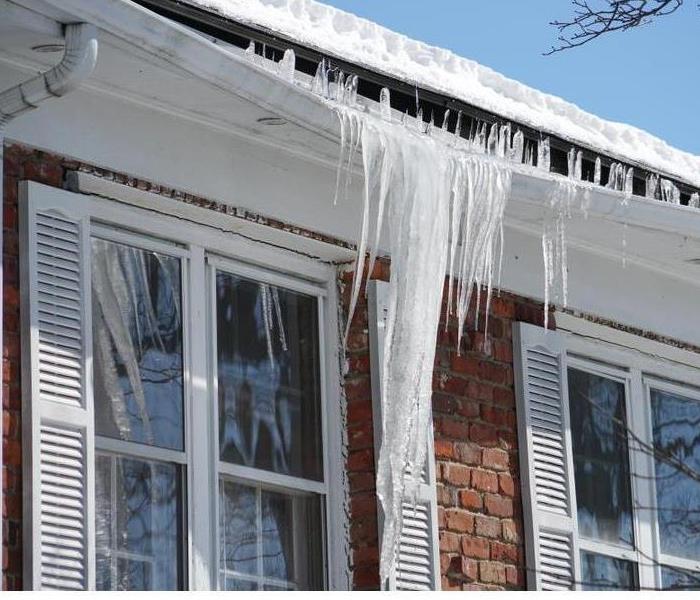 Don't let these pesky ice dams get in your way! Our team can eliminate them with our water damage restoration!
Don't let these pesky ice dams get in your way! Our team can eliminate them with our water damage restoration!
During the coldest months of the year, ice dams can be a serious problem for homeowners. The excess water that builds up can cause serious water damage and even mold growth. Avoiding this scenario means knowing how to prevent ice dams from forming. We’ll show you how to curb it below!
Clean Gutters Before Winter
Once the first snowfall hits, it becomes significantly harder to undo a gutter clog. Make sure that you clean them thoroughly before the wintertime to prevent ice from forming. If you hit a period without snow, consider giving them a touch up.
Measure Attic Insulation
If your roof and interior ceilings get too cold, the odds of an ice dam forming increase. To curb this, measure your attic’s insulation levels. If they don’t meet the grade, consider installing new insulation.
Install Heat Cables
Keeping snow and ice off your roof helps to prevent ice from forming at all. These run in a zigzag pattern on your roof and keep it warm enough to melt any excess snow and ice. These can be installed by a roofing professional to minimize the risk to your person.
Water Damage Cleanup With SERVPRO
SERVPRO of East Boston, Chelsea, & Revere understands that water damage accidents are bound to happen. If you’ve experienced the side effects of an ice dam, our team can successfully extract the water and restore your structure and contents to normal. Contact us 24/7 for water damage assistance!
Avoid Water Damage by Doing These 3 Things | SERVPRO of East Boston, Chelsea & Revere
11/17/2023 (Permalink)
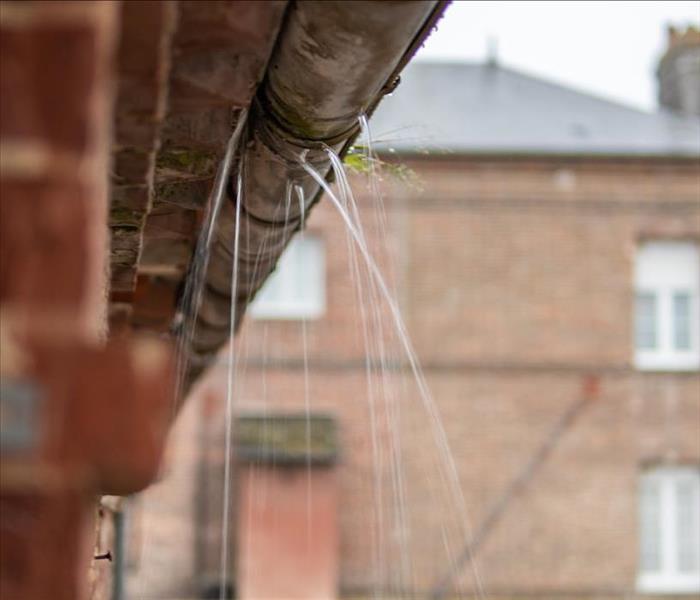 When water damage creeps in, SERVPRO of East Boston, Chelsea & Revere is here for the rescue. Contact us today!
When water damage creeps in, SERVPRO of East Boston, Chelsea & Revere is here for the rescue. Contact us today!
Water is a focal point in our homes and in our community, day in and day out. While water flows through our pipes on a daily basis to help us perform our basic household tasks, Chelsea Creek and the Massachusetts Bay is right off to the east, making our community truly surrounded by the expansiveness of water.
Whenever water is present or near our homes, the risk of experiencing water damage is increased. However, that possibility is not a guarantee as long as you know where to look and what to do as soon as you suspect a water problem.
Doing these three things regularly can help you avoid significant water disasters in your home:
Check on Your Appliances
If you are a homeowner, we would bet you have dealt with at least one faulty appliance during the time you’ve owned your home. Appliances that use water to function get used so frequently in our homes that they can easily malfunction or break if they get overworked or are left unattended for too long.
Checking on each appliance before using it can help you spot any emerging issues. New drips, a slow leak, or a deteriorating seal or water line should all be investigated and fixed before using the appliance in question. You should also make note of how old each of your appliances are and replace them as they age, since older equipment can sometimes become more unreliable the older it gets.
Address Roof Issues
Water damage can also occur because of the power of Mother Nature. Heavy rain can infiltrate through gaps or damage in your roof and leak down your walls.
A single undetected roof leak can cause your entire home to become compromised with water damage and even mold growth. Inspect your roof after each storm to check for missing shingles, dents or cracks, or even for obvious structural damage from a fallen tree or branch.
You should also treat your gutter system with care by clearing it out on a routine basis. Gutters can easily become clogged with leaves and other yard debris that pose serious issues to your roof.
If water can’t flow away from your home, it will back up on your roof and force its way into your attic. It could also pour over the side of your roof and lead to a soggy basement if it gets past your foundation.
Check on Your Water Lines
Water is constantly flowing behind your walls through your pipes and water lines. You probably don’t think about it on a daily basis, but a single pipe leak or burst water line behind your wall could lead to extensive structural damage in an instant.
Take the time to locate each water line in your home and routinely check them for signs of wear and tear, and add a line of caulk around any seals that are worn. You should also know how to turn off any water valve in your home and know which valve controls every pipe, faucet or sink.
Finally, keep an eye on your water bill. If you open up your bill and are surprised at how high it is even though nothing much has changed around your home, it may be due to a hidden water leak. A simple drip somewhere can lead to gallons of water being lost in a single day, which will severely impact your monthly budget.
Water damage can happen quickly and quietly. Contact SERVPRO of East Boston, Chelsea & Revere as soon as you discover the problem
Expert Water Damage Restoration for Commercial Properties in Boston: SERVPRO of East Boston, Chelsea, & Revere
4/26/2023 (Permalink)
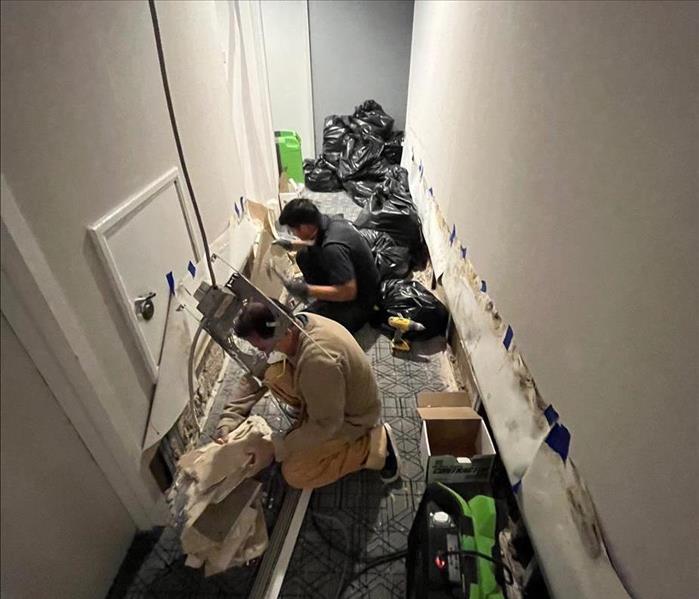 SERVPRO of East Boston, Chelsea & Revere is available 24/7 when water damages your commercial property. Call us now.
SERVPRO of East Boston, Chelsea & Revere is available 24/7 when water damages your commercial property. Call us now.
Water damage is a common issue in commercial properties in the Boston, MA area, and can result from a variety of causes, such as floods, storms, plumbing issues, and leaks. It's important to address water damage as quickly as possible to prevent further damage to the property and minimize business interruption. That's why it's crucial to work with a trusted and experienced water damage restoration company like SERVPRO of East Boston, Chelsea, & Revere.
As part of the SERVPRO Team Luzzi network, they have the expertise and equipment to handle any size water damage restoration project. They start by identifying the source of the water damage and taking steps to stop the water from flowing into the property. Then, they use specialized equipment like pumps, air movers, and dehumidifiers to remove standing water and dry the affected areas.
SERVPRO of East Boston, Chelsea, & Revere also offers mold remediation services, as mold can quickly grow in damp environments and pose a health hazard to occupants. They use industry-leading techniques to ensure that all traces of mold are eliminated from the property.
In addition, they work with property owners and their insurance companies to navigate the claims process, making the experience as stress-free as possible.
Overall, if you're dealing with water damage in a commercial property in the Boston, MA area, SERVPRO of East Boston, Chelsea, & Revere is an excellent choice for restoration services. Their experience, expertise, and commitment to customer satisfaction make them a leader in the industry.
Water Power Unite!!
4/1/2021 (Permalink)
Water is not always bad.
Modular hydropower
While existing hydropower is among the least expensive sources of electricity, building a new plant can be expensive. Modern technologies are needed to reduce installation and civil works costs. One potential answer is modular hydropower, which uses separate, similar components that can be constructed off-site then easily integrated into new or existing sites and scaled to greater capacities.
Modular hydropower systems for non-powered dams and other untapped sites can lower construction costs and reduce environmental impacts. For example, a 24-foot long and 16-foot high prototype dam, composed of six precast blocks, was built in Massachusetts as part of the HydroNext Initative in order to lower cost, improve performance, and promote environmental stewardship of hydropower development.
Powering non-powered dams
Today hydropower is the largest renewable energy source in the U.S. Still, tens of thousands of dams across the country don’t produce power. Adding generation equipment to these sites could add up to 12 GW of new hydropower capacity to the grid, and using existing dam infrastructure can lower construction costs and reduce permitting time—meaning hydropower is added to the grid faster. Because 49% of hydropower capacity is owned by the U.S. Government, federal dams represent a big opportunity to develop non-powered dams.
Pumped-storage hydropower
Pumped storage house (PSH) works like a big battery. It pumps water to a higher elevation, which can then be released at any time to turn turbines and meet energy demand. As the largest form of utility-scale energy storage, PSH helps stabilize America’s power grid. It can respond quickly to grid instability or power outages and balance variable generation, such as from wind and solar. The country’s 42 PSH plants help make the electric grid reliable and resilient, but Energy Department-funded research shows we can add even larger amounts of new, flexible, low-cost PSH.
Tidal energy
Tides occur worldwide, but making electricity out of them requires a 16 foot difference between low and high tides. While there are no permanent tidal power plants in the United States yet, conditions are good for tidal power generation in the Pacific Northwest and the Atlantic Northeast regions. The Energy Department has funded research to develop new ways to install, maintain, and decommission tidal power plants. Recently, the Energy Department continued funding for Verdant Power, Inc. to optimize a way to deploy and retrieve three tidal turbines together as a single system with one on-water operation without diver support.
Wave Energy
Ocean waves pack immense energy. The challenge for scientists—and a focus of the Energy Department—is developing technology that can safely, reliably, and cost-effectively convert wave energy into usable electricity. But once that’s done, the potential for wave energy to supply power to major cities and distributed applications—like naval bases, desalination plants, and subsea data centers—is high. To address this challenge, the Energy Department-funded the Wave energy prize, an 18-month public competition, that ended with prize winner AquaHarmonics demonstrating a five-fold increase in the energy capture potential of their MHK device—which the two-person team built in a garage.
Different types of water damage.
9/22/2020 (Permalink)
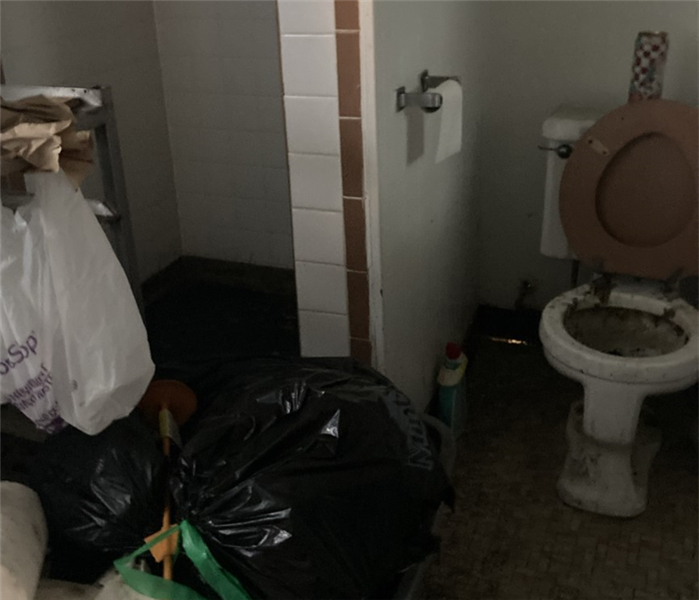 Black water from a sewage back up can not only cause a lot of damage but create an unhealthy living environment
Black water from a sewage back up can not only cause a lot of damage but create an unhealthy living environment
There is so much more to water damage than what you can see that is wet. Along with hidden damage you have to be aware that water damage can come from a wide variety of sources. Some of which may be in your home while others could be caused by nature. That being said where the water comes from is all classified and treated differently. It is important to understand these different types of water classifications as they should all be treated differently.
One important thing to keep in mind is that these water classifications do not have much if anything to do with the actual color of the water but more so the level of contaminants in the water itself. There could be a lot of bacteria, virus, or chemicals in the water that you can not see. It is essential that you keep out of the water if you are not sure of its contamination level or if you think that it could be Black water. Reducing exposure to your self or spreading the contamination around to other unaffected areas of your home.
Lets take a look at the types of water that can cause water damage.
Clean Water:
Clean water is also known as category one water, the safest of all water damage. This type of damage usually comes from an unattended overflowing sink or a broken water line. Consuming this type of water would pose no health risks to humans or animals and thus, is usually the easiest to fix.
Most cleaning companies would go in, inspect the incident, extract the water, and then thoroughly dry the area. Because there are no microbes in clean water, the process isn’t as complex as it would be with more serious cases.
Gray Water:
Gray water is more serious than clean water and can occur if you leave clean water dormant for a period of over 24 hours. A good example of a gray water incident would be a toilet overflowing. There are microbes in toilet water and consumption of that water could lead to illness and at the very least, an upset stomach.
One of the most important pieces to gray water is preventing the spread of the microbes inside the water. That’s why you usually leave the work to the professionals. But if you want to start the restoration process before the service crew arrives, make sure to keep your skin covered at all times to minimize the risk of exposure to your body and to other areas of your household.
Black Water:
Black water is the most serious of all three water damages. This type of damage usually occurs due to sewage or, in some cases, natural disasters such as hurricanes and heavy flooding. It’s extremely important that you keep yourself away from black water as it can contain anything from chemicals and pesticides to bacterial diseases that will do serious bodily harm if they get inside you.
If you are in a situation where black water has contaminated your home, call the professionals Do not clean it up yourself. You won’t have the proper equipment or knowledge to properly clean and remediate your home.
The dangers of Black Water shouldn’t be ignored. Even being exposed to the air around black water can lead to serious respiratory problems. Coming in contact with it can lead to serious illness and even death in some cases.
Please keep in mind that often times this water is not actually black in color. Where the water comes from determines its classification. This could be water that comes up through a toilet or sewer system as an example. Visually the water could look very normal yet contain chemicals, microbes, virus and or bacteria. If you have water damage in your home and you are not 100% sure where it came from call the professionals.
Do you have time if it is clean water?
No you do not have extra time. Once clean water leaves the confines of its controlled source it is exposed to a lot of different ways. Water can pass through a wall that a rodent may have left some droppings. It could be left pooling and an insect could come in contact with it. As it sits it is possible spores and fungi can begin to make their homes on wet materials become permanently ruined or worse grow something more sinister.
Regardless of where the water comes from damage seems to come from an overflowed bathtub or leaking pipes, immediately call for help. If allowed to sit, clean water can turn into gray water which will only do more damage to your home. This can make things worse and it can also cause permanent damage. If this is an insurance claim the insurance company could determine this to be secondary damage and deny coverage for it leaving you on the hook for some serious expenses.
No matter what the cause of the water loss Say you find yourself in a situation where the water damage was out of your control. It can bring its own series of problems such as mold, sewage, or traditional flood damage from a storm. There are also solutions for these types of problems as well.
What to Do in the Case of Molding
One of the biggest problems that can arise from water damage is molding. This can occur whenever water damage is present for a long period of time, usually in the case of heavy flooding or sink overflow.
If mold is left by itself, it can easily destroy the structure of your home and cause damage that’s permanent. It can make furniture useless and decorate your walls with green spots. Therefore, it’s important to call right away if you start seeing mold show up.
Companies that have 24/7 emergency cleaning services are especially good to know about because they can assist you whenever and however you want. This makes mold removal much easier to handle.
DO NOT tackle Sewage Damage
If you have sewer damage make sure you call a professional immediately. It’s not only black water but once the water subsides, there’s going to be bacteria on bacteria–not to mention the bad smell–inside your home and only the qualified professionals will know how to take care of it.
If not taken care of right away, the sewage damage will eventually lead to structural injuries and contamination.
Flood Damage
We have seen increasing flood events here in the Northeast coupled with failing drainage systems, flooding is becoming a more serious issue that affects homeowners across. Sometimes, even with your best efforts, the damage occurs, nonetheless. So, what do you do?
Number one thing to do is get out of flood waters the speed at which they travel can even be life threatening in as little as an inch of moving water. Once you are able to safely return to your home it is important to take an inventory of what is and is not still within the home. Coupled with what is and is not damaged. Call your insurance company and start talking about rebuilding. Checking your policies before you need them is the best way to ensure you are covered for wat ever life throws at you.
Rise in water damage claims
6/30/2020 (Permalink)
 Flooding and water damage events are on the rise. So too are water damage claims for homes and businesses
Flooding and water damage events are on the rise. So too are water damage claims for homes and businesses
An article from March of 2019 highlights key numbers on water damage claims from insurance companies. Surges in water damage claims along with the climbing average cost of each claim is alarming.
With all the technology and advancements we have to wonder what is going on. People maybe not being home as often could play a major role in the length of time water problems go unnoticed.
Another reason for a rise in the water damage claims are overloaded drainage systems and major rain and flood events. While we have periods of drought these major rain events quickly overload systems and cannot be absorbed by the earth fast enough. Running into roads, drains, homes, and businesses.
What kind of water damage you have is another major player in the cost of the damages. We here at SERVPRO of East Boston Chelsea, Revere have seen a major uptick in sewage calls. This damage requires immediate response as well as a lot more demolition due to nature of the potential contaminates within the water.
A new report has found that the number of water damage claims resulting from leaks have surged in recent years, as other types of claims have declined in frequency.
The report, prepared by Verisk Analytics’ ISO unit, found that one in 50 homeowners filed a water damage claim each year, between 2013 and 2017. This 2.05% frequency rate is a noticeable increase from the 1.44% frequency rate annually for the period between 2005 and 2009. Industry figures have also highlighted that the increase in water damage claims occurred even as other types of claims (such as for fire) have declined in frequency.
ISO additionally found that, in 2017, the total amount of insurance payouts for water damage was $13 billion. The average claim cost about $10,000.
Several industry leaders have confirmed that water damage is just as rampant as the data reveals.
“Wildfires, hurricanes and tornadoes catch headlines, but the reality is that the No. 1 kind of risk that the everyday consumer has is a water claim,” USAA assistant vice-president of P&C innovation Jon-Mike Kowall told Wall Street Journal.
Major insurer Chubb has also recently released data outlining that the number of annual water claims costing more than $500,000 has doubled since 2015, while those that cost over $1 million have tripled.
Insurance executives say that there are several factors driving the costs higher. These include: aging homes with potential plumbing failures waiting to happen; expensive homes filled with valuables that are vulnerable to water damage; and more homeowners wanting their laundry room on an upstairs floor.
Although insurer’s payments are increasing, it does not mean they are obligated to pay every water damage claim. Wall Street Journal reported that, since the 1960s, standard homeowners’ policies have excluded storm surge and river flooding. Similarly, homeowners’ policies typically cover “sudden and accidental” damage, not routine plumbing maintenance. Insurance executives have warned that homeowners who neglect an obvious slow leak for months until the damage reaches critical levels could get into a coverage dispute.
https://www.insurancebusinessmag.com/us/news/breaking-news/study-water-damage-claims-surging-161741.aspx
Getting back to business to find water damage
6/29/2020 (Permalink)
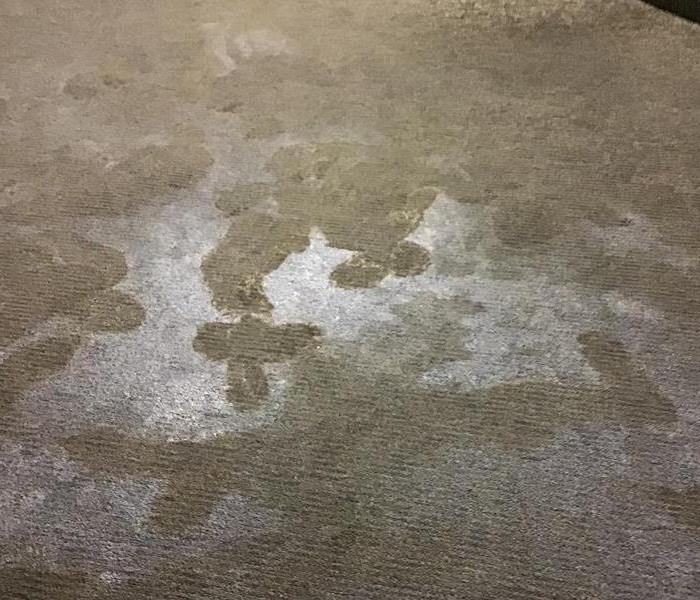 When water damage sits on a carpet for months you are bound to see some things growing from it. This was very slippery
When water damage sits on a carpet for months you are bound to see some things growing from it. This was very slippery
Water.
Water is the life force of the planet. Nothing would survive without it. Yet it can be one of the most destructive forces we know. The funny thing about water its destruction can be instantaneous or slow and steady over the course of days weeks months or even years.
Today SERVPRO of East Boston would like to show you a case study on the various ways a water loss can affect your building.
Let us start out by setting the stage:
Unprecedented times have forced your business to close. You send your employees home for their own safety. You have the management team set the building into idol mode. For the HVAC system and lights to ensure you are saving on costs and you have them lock it up and go home for their safety as well.
Time moves on and still you remain closed. You determine you do not need to act on the building because you shut it down and no clients have been in or out. Right? Weeks turn into months and still no signs of opening. All of a sudden there seems to be a light at the end of the tunnel word is out that you may be able to open your doors soon. New protocols will need to be implemented the whole building needs to be cleaned all your equipment needs to be wiped down and situated. Staff needs to be trained.
You call up your regional manager to set the wheels in motion to get things going. The area managers are all called up for action. They head into the buildings and start to assess in the equipment and building for cleaning, get the air turned on and so forth. Laying
out equipment, created one way paths, assess what else is needed.
Then it happens one of your area managers calls after arrival to the building. Something is really wrong there is water everywhere. The whole place is flooded. You ponder and thing to yourself that is not really possible we have a big place send me some photos. One photo is a bubbler leaking water all over the locker room area. Ok well the locker room area is mostly tile so that can’t be too bad.
The images continue into the main hallway. Which by the way is carpeted, as you follow the carpeted hallways it becomes clear there is a slippery film coating the entire top of the carpet. How long does it take for a film like that to develop?
You keep walking it flows through walls, into other areas where you have thick rubber flooring cemented to the floor below. Did it get under this this layer of rubber? Is that possible. How far into the main area of room did this water go. As you walk through increasingly wondering how bad can it be?
You see the water line it is halfway through the building. As you stand there saying well its only half way its manageable. You see more walls that it looks like it went through. Oh no please not in that room you think to yourself as you anxiously walk towards the swinging glass doors. Slowly opening them to find your wood floors look intact. With a big sigh of relief you say wow we dodged a bullet.
Time to call the professionals to assess what the next steps will be. Enter the professionals. You meet them at the building the next day to show them everything you found proud of the fact that the water was only half way through the building and that you do found that your precious floors were not affected.
Then they do something you did not do.. They look up noticing a lot of black spots on the ceilings and walls by the windows and the AC vents. The then look down but not the way you looked down they peel away a rubber vinyl baseboard just a little bit. They do this in a few rooms finding a lot of evidence of trapped water as they go.
They walk into that room you were so proud to tell them that they water did not look like it went into that room. They pull at the baseboard on the wall next to that rubber floor you know water affected. What happens next brings you to your knees. That wood floors is a raised floor built on another subfloor built on another subfloor. sitting on top of a liner sitting on top of cement. There is trapped water under it under almost all of it. While topically this whole room looks fine. Hidden behind a wall, under a floor water trapped in a dark space where the air does not move and the heat builds as temperatures outside continue to climb.
Finding out it is not what you can see that is the problem or where you look. It is what you look behind and what you pull away from walls and floors that show the true extent of the damage. As you absorb that the damage is far more extensive than you imagined reality sets in. Your light at that end of the tunnel just moved a lot further way. How do you get through all of this? Will you be able to hold out long enough for the repairs to be made? Will your customers come back when you are re-opened? Where do you start with fixing all this?
SERVPRO of East Boston is here to help. We have a vast network of vendors that will allow us to get your project going as soon as possible. We also always work closely with every insurance company. They know that SERVPRO has a reputation for being efficient and through. We are a trusted resource for getting the project done and getting you back to “Like it never even happened.”
So you want an Aquarium...
1/15/2020 (Permalink)
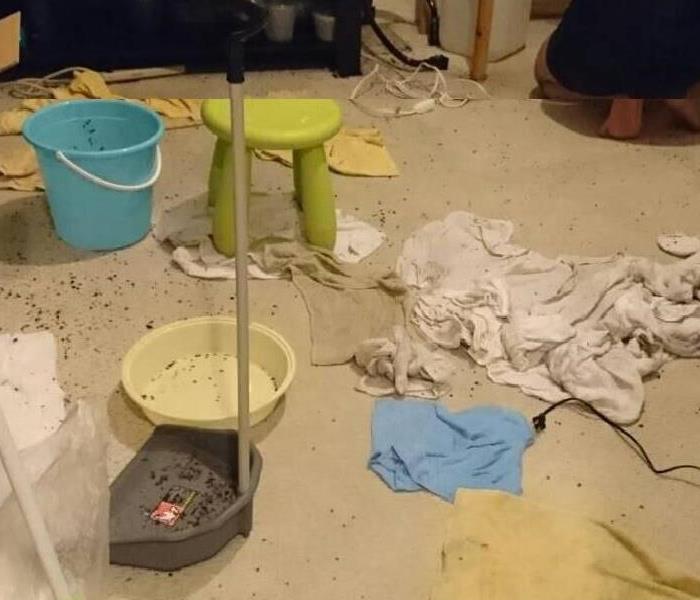 Fish are pretty water damage is not
Fish are pretty water damage is not
The weight of water
So, you binge watched that aquarium show. Saw these beautiful show tanks mostly saltwater that have eccentric designs, ornate fixtures and some of the most colorful fish you could imagine. What could be the harm. I can watch a YouTube video on properly setting up the take with the filtration system and get this done or something similar that I can maintain, and my friends will love it. A stunning piece in your home to be the center of conversation.
What do you do not see on those shows are the homes structure, foundation improvements or assessments? Safeguards that will reduce tank failure, or equipment failure. The other problems that many do not think about is the weight of the water.
Water typically weights 8.34 pounds per gallon. A tank you see on that show typically has two systems. A front show tank and a back of the house tank that typically has the same volume of water. You then need to have another tank that will cure at least 10% of the total volume of water you have in the two tanks.
Let us take a modest 90-gallon show tank for this example. The tank size will be approx. L: 48” W” 18 H: 25”. You are looking at the weight of the tank to be 160 pounds, full of water it will be about 1050. This is before you add the weight of any rocks, or ornamental decorations. The lighting too will all add weight as well as the pumps and such for circulation.
What sort of support structure do you have existing that can hold this level of weight? Oh, you are going to custom build one. That is great that too will add to the load you are putting on that floor area will you be using 4 points of contact or will you be doing a continuous brace support across the footprint of the structure? Once you have thought of all of this have you considered the added load on that floor and the structure that it is in. Can your floor hold and extra 1200 pounds of weight safely?
Let us dive into a structural engineers thoughts and ensure that we know what we are doing. The basic constructs of a home. There are multiple factors and many added weights to consider. The dead load of the floor is everything that will always be there, pipes, joists, ductwork, flooring materials this is approx. 15 Pounds per square foot. There is also the live load which is the furniture, decorations, appliances, people and aquarium. Now these two are not the only thing you need to look at one must use the safety factor which is usually between 1.5-2. So the home is safe with 1000 pounds but could collapse with 1500 pounds of weight.
The other factor is that people walking around for short amounts of time does not put the same pressure on these areas as something stagnant that will sit for potentially years on end. People will get up and move over time even furniture will be moved around and changed. An aquarium will remain stagnant.
SO you have assessed that your floor can hold the water and extra weight. How much damage could 90 gallons of water really cause for damage anyways. Yes water always wins, no matter what you are doing. If you have a slow leak and do not notice from a pipe that runs behind or under the take this can be extremely costly. To put it into perspective Typical appliance leaks on average cost well over $13,467 dollars to correct. Chalk it up to faulty pluming and you are looking at over $17,250 . These figures do not take into account the materials you have in your home. Do you have carpet, laminate, wood floors, tile. What floor is this tank on the first floor or do you have a split level ranch? If there is a finished floor underneath where you place this tank these costs could be much more.
All of this being said did you know there a lot of key ways an aquarium can leak. Here are some of the things that can happen a hose can split or burst off of a fitting, A connector could fail, a skimmer can overflow, drains could get blocked, one of the check valves could fail, a pump could stop working, a siphon could happen, the tank itself could fail. While making water you could forget about the hose running that is filling the container, float valves and sensors could get stuck or just not work. The powerhead could come unattached, algae and salt can build up and change the waters flow. An O-ring just as on a toilet could let go. Did you think of any of this while you were watching that show? They did.
Did you add additional coverage onto your homeowner’s insurance for this new addition to your home? Does it even matter? Water damage is water damage, right?
Wrong water damage caused by a fish tank falls under pets. Since damage to your own home caused by pets is typically not covered by insurance you will be on the hook for this damage on your own. If you live in an apartment even having additional coverage may not be enough.
These statistics are not meant to scare you, but they are meant to get you thinking. We do not imply or suggest that meeting specification requirements alone will ensure you do not have any problems and we do not guarantee that any of the advice on costs of repairs or coverage issues are set in stone. We do advise you talk to professionals in various industries prior to getting too far into the process of setting up a fish tank in your home ensure you are not subjected to surprises. This information is for informational purposes only and each situation is different and must be properly researched.
Statistics for water damage numbers were found on.
https://www.waterdamagedefense.com/pages/water-damage-by-the-numbers
Structural information was supplied in part by
http://www.african-cichlid.com/Structure.htm
Water Water everywhere!!!
11/26/2018 (Permalink)
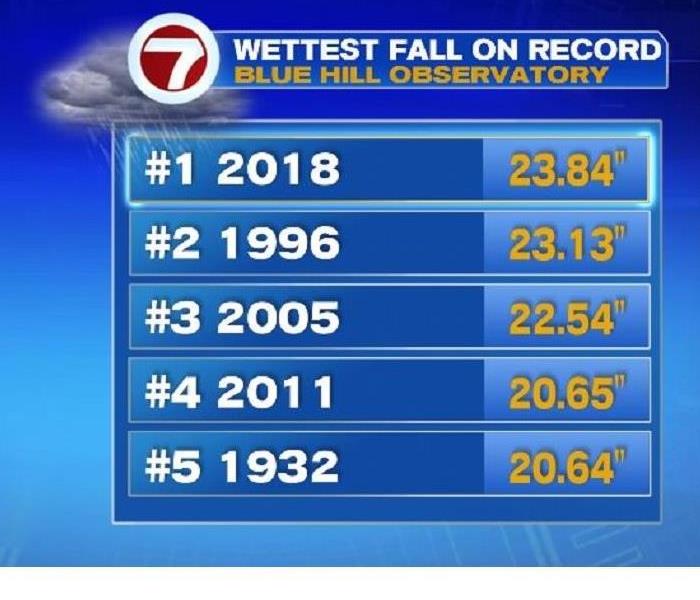 Fall in Massachusetts has been the wettest on record with still a few days and inches to go. This spring we could be in for some serious flooding.
Fall in Massachusetts has been the wettest on record with still a few days and inches to go. This spring we could be in for some serious flooding.
Do you feel like it has been an endless rainy season in what is notoriously a dry season? You would be right. We have some of the oldest records for weather in the country right here in Mass. Blue Hill records date back to the late 1800’s and as of November 26, 2018 we had achieved the wettest fall on record. With more rain on the way it is shaping up to be a wet one.
This rain can have a big impact on winter storm damage to homes and businesses. How can that be you ask? Here are just a few examples.
Freezing: Water is unlike any other element on the planet. It expands as it cools rather than shrink. This causes all sorts of problems. If you have a small leak in the home from all this rain that is out of sight. When the cold weather sets in it will freeze. Many times, this freezing will occur and cause a lot of damage. Since water expands as it freezes any area that is saturated will expand either allowing more water in or cracking any materials that is stuck inside of. Be it a roof, wood framing, corner of a home or foundation, etc..
So, what can you do: Have a trusted contractor walk around the house look into the attic, basement, crawlspace and work on detecting anything out of the normal. Any edges of your home that show signs of rot, or water damage, Check inside the attic for any damp or wet insulation. Look in the crawl space for any signs of water coming through the foundation. Damage to any flooring, place any insulation over pipes that may have fallen off. Clear out all the gutters so that nothing is blocking the down spouts either from the top or at the output on the bottom.
Saturated soil: Soil that is unnaturally wet for extended periods of time can have damaging effects on trees. Many times, the roots have a hard time holding onto the soil and in high wind events can cause the tree to topple over many onto a home or car. There is also the effect water has on the roots themselves. If the tree is not prone to doing well in significantly wet soil the roots can start to rot. This rot can happen in even a healthy-looking tree causing it too to fall over.
So, what can you do: Walk your property ideally with a tree care professional. Have any leaders removed. Trim any branches that seem precarious. Inspect the trees and roots for any thing that looks like it will not hold during a storm.
Water intrusion: All this water has to go somewhere many times it does not have the ability to run off or be absorbed by the ground at the same rate when frost starts to set it. This allows the water to travel further than it normally would. Meaning there could be flooding events in areas that there are not normally any. It may also travel for a distance then a cold snap will freeze it in place. This causes a crack in a foundation. Allowing the warm air from your home to get out thawing out the water. This water will travel into your home as it thaws if left unnoticed you will have a major problem on your hands
As we continue to see rivers rise during a time of year that they normally slow to a trickle we have to be worried about what will happen. In the spring when all the snow melt, and runoff drains into already overloaded springs, streams, and rivers. We will see a lot more flooding events and now is the time to prepare.
So, what can you do: You can learn where your existing flood zones for your area are. See if you are downhill from any streams, rivers, ponds really any bodies of water. Follow the link below if you are not sure. https://msc.fema.gov/portal/search
It is a great time to look at your insurance policies. Make sure you have flood coverage. This will not be tied to the regular home owner’s insurance you have. It is a separate policy. Look it over, make sure you have both home coverage as well as contents. If you are not in a flood zone that is the best time to get flood insurance, it is much more cost effective. It can also protect you should the zoning change during a reevaluation time.
As our climate changes, storms become more intense and the extreme weather. It is important to know that those hundred-year storms events will be more like 3-year storm events if not more frequent than that. Knowing what water can do the soil, trees, and your home is key. Being prepared is more important than ever. Finding water damage before it becomes a major problem is going to help you keep things under control. Developing good home inspection habits will help avoid costly repairs later.
Water Prevention Technology
11/13/2018 (Permalink)
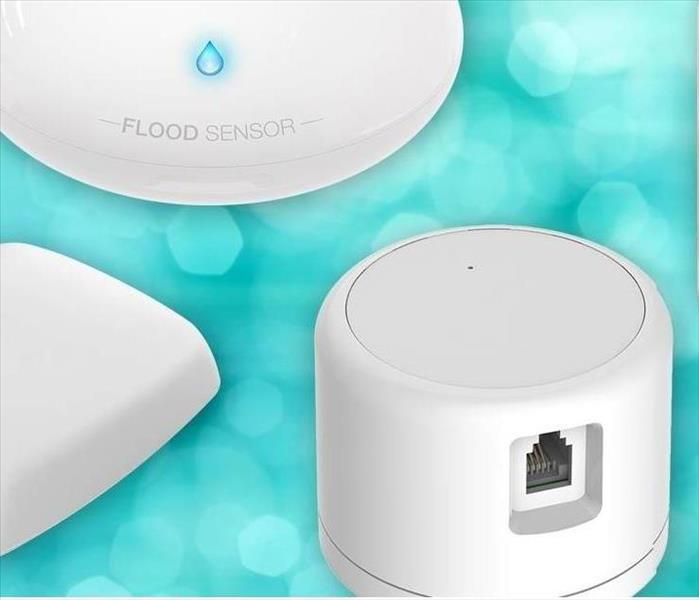 Water damage even a small leak can result in big damage. Learn what options are available and best suit your lifestyle and needs.
Water damage even a small leak can result in big damage. Learn what options are available and best suit your lifestyle and needs.
SERVPRO of East Boston Chelsea & Revere we see our fair share of the intense damage cause by water. We are always trying to keep a pulse on how these damages can be prevented. Searching out new technologies for our clients and putting the information out for our clients to find.
Over the years we have seen great advances in these areas. Streets that can absorb gallons upon gallons of water which aids in reducing run off and drainage and sewer system overload. The ability to recycle and clean water to reduce pollutants and contaminates within the environment. There has also been extensive research on ways to harness water for electricity consumption. The ones that directly affect your homes and businesses are the ones that get us the most excited.
We should all be aware by now of the importance of smoke detectors and Carbon monoxide detectors. Many of us even keep a fire extinguisher on hand. Yet so many of us fail to take the same precautions with water.
While the amount of damage caused by a fire is extensive and does cost the most. I highest number of claims called in comes from water damage. Often times these claims stem from leaks that have gone unnoticed or have happened when no one was home. A poorly timed disaster could happen while you are on a vacation, at a family function or away for work. Having no alarm system or warning system in place can lead to a great deal of damage.
There are answers and they can be autonomous and tied directly to apps on your phone to ensure damages are mitigated and any potential issues are caught as soon as possible. The variety of options run the gamut in price, engagement and notification options.
Simplicity and ease of use for some basic peace of mind comes in the way of battery-operated or simple plug ins. Some of the most cost-effective devices in this category can tie directly to your cell phone. The water will prompt the device to send a message to your cell phone. They often will not have an alarm that would go off within the home.
Others are a bit more intricate and required them to be built into the infrastructure of the home. These are similar to the built-in smoke detectors in your home. These devices may require to be plugged into an actual outlet but will work with your homes WIFI. They have water sensors you can place in front of items such as boilers or even on pipes directly that will alert you of temperature changes.
There are more that are full smart home ready devices. They can not only tie to your smart phone but also your Alexa or google home devices providing automatic shut off options as well. These smart home devices have some intricate features that allow them to go as far as turning off the water if a leak is detected. Due to this feature you will need the aid of a certified plumber to install them making the upfront costs a bit more.
As with some of the higher end home service options there are monitoring centers staffed with trained individuals that can call and notify you of any changes within your system. This could even assist with troubleshooting what the problem could be and how to fix it.
Do you have a property that you rent out? Are you a property management company that has a new tenant and seen a spike in the water usage of a particular unit? Well they have a device for that as well. It will monitor water pressure, temperature and which devices are consuming the water. Do you have toilet that is running constantly that a tenant did not tell your about? Has the washing machine see its last day and uses far more water than the newer models. Does that dishwasher have a leak that no one sees? These sensors can help to assess and determine your best options as well as catching a problem long before it even becomes one.
As time progresses and more of these items are adapted and technology changes. There will be more sensor options. Some have even begun to offer them for Gas shut offs as well. Commercial businesses are always looking for cost cutting measures. These water sensors can be an integral part of the assessments on when to upgrade appliances and aging systems.
It is imperative with water being such a scarce commodity with essential for life be we all take steps to ensure it is not wasted. Saving us all money and protecting the planet. Here at SERVPRO we must ensure our team and our clients know about the options out there for protecting their homes and businesses.
Below you will find a link to some of the key products that have been rated. While we understand it is a somewhat older article it is a great assessment of the range of products available.
https://www.tomsguide.com/us/best-water-leak-protectors,review-4953.html
Sinkholes and waters role
8/9/2018 (Permalink)
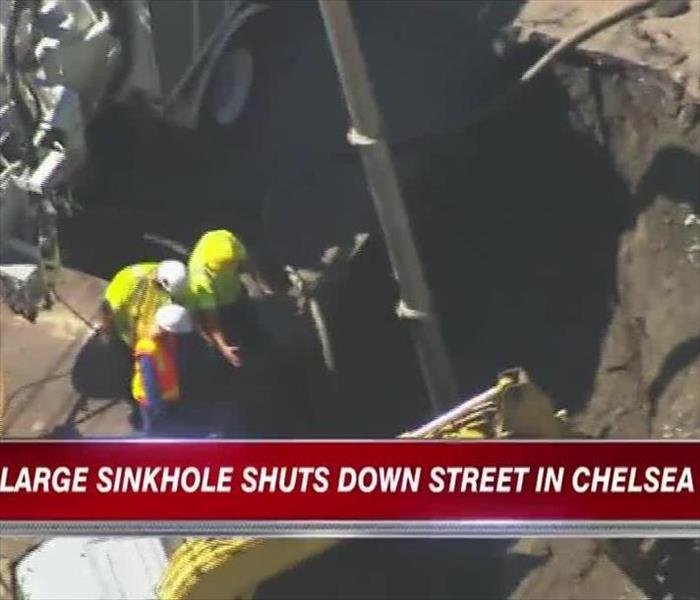 Water is really to blame for all sinkholes be it a natural occurring event or a man-made problem from aging pipes breaks.
Water is really to blame for all sinkholes be it a natural occurring event or a man-made problem from aging pipes breaks.
Sink holes. What causes them? How does water affect them? What to do when one opens up near you.? Is it covered by insurance?
Florida is not the only area that can experience a sink hole. To better understand how and why they happen a little geology lesson is needed.
What causes them?
Bedrock that has a lot of limestone, carbonate rock or salt deposits will be more likely to erode. Resulting in holes that can no longer support the ground above it. Sink holes can also develop if an object such as a building is built on soil it too soft to support the weight.
How does water affect them?
The cause of this erosion is from water. As water passes through the top layers of soil, plants, roots and decaying materials making the water more acidic. As more material is eroded out of the rock the hole becomes larger eventually too large to sustain the earth that remains above it. These holes can open on a street, under a building, or on the edge of a cliff.
What to do if a sinkhole opens on your property?
Vacate your home or office immediately. Contact emergency professionals to have the area roped off. Reach out to your insurance company to have them send out an adjuster to make an initial assessment. Sinkholes NEVER get better. You will have to work with engineers to decide on the proper course of action. Getting someone to come out and take soil samples every 5 ft will provide a good picture of what is going on. Note this testing can take 3-5 weeks and may require payment from you. It is not cheap with average cost running $4,000-$8,000. Also know many insurance companies do not cover sinkhole damage unless you have separate insurance similar to flood insurance. Know what your policy covers if you think you are in a high-risk area.
As more and more flooding events occur these events will increase. As aging pipes fail and water is forced out into these already susceptible areas washing out the support materials even faster that normal.
There are 3 different kinds of sink holes cover collapses sink holes, cover substance & solution sink holes. They also have two ways they are created naturally and manmade. There is nothing that can be done about the naturally occurring ones. The man-made ones that is a whole different story.
The man-made ones stem from pipes underground breaking and washing away the soil they are sitting in. In turn they are compromising the materials above them. While natural sink holes have the same risks and cause the same problems. Maintaining pipes and catching small leaks before they become big problems is essential to reducing the damage that they can cause.
Watermain breaks and sewer systems that are overloaded. are a contributing factor to sink hole development. When the pipe breaks the water will find a way to go somewhere. The force pushing the water through those pipes is immense and will continue to push water through if it is broken or not. Water will expand out from the break forcing the earth away as well.
Sewer systems that become overloaded will force water out of a controlled pipe system onto the streets, sidewalks, front yards allowing it to get into a lot of developed ground that has been leveled with sand allowing it to wash away.
Which is why it is essential to never drive through a flooded area. You can not see if a sink hole has been created. Water is level with the surface that it sits on. This water is always muddy and the bottom where the ground is can never been properly assessed. These sink holes can be a few feet or upwards or 50ft or more. They can also release a lot of toxic fumes contaminating the water. Please stay out of the waters and wait, go around and seek alternate route.
Treating a flooded road or area the same as if there was a storm event is essential for your safety. Only 6inches of moving water can knock someone off their feet. If you are off balance and fall into contaminated water, you should seek medical attention and rinse the water off immediately. Taking a sample of the water to the doctors office can help them assess your real risk. Toxic chemical, bacteria, and virus thrive in water and can be ingested if you are yelling for help or over exerted and are breathing through your mouth. Allowing that bacteria to enter your digestive system and or your lungs.
It is better to just be smart and stay out of the area. Do not drive around barriers. Do not walk through the flooded water if you can avoid it. Do not drive your car through these roads or flooded our areas. Again it is impossible to know how deep they are.
Remember get out of immediate danger, call authorities, and DO NOT DRIVE OR WALK through flood waters.
Photo courtesy of
https://whdh.com/news/large-sinkhole-rips-open-street-in-chelsea/
Freeze drying and why you should care
7/31/2018 (Permalink)
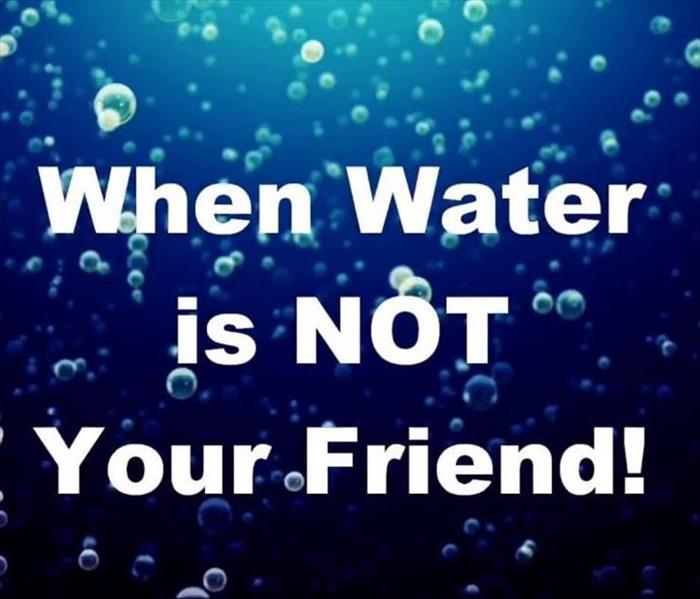 Water is not always your friend. Especially if you run an office that requires a lot of documents and secure information to be kept.
Water is not always your friend. Especially if you run an office that requires a lot of documents and secure information to be kept.
Do you have a lot of important documents in your office?
Is your office subjected to HIPPA regulations or client and patient confidentiality laws?
What is your plan for all those if you have a water damage event?
Did you know that SERVPRO has a solution for that?
It starts with a relationship with your facility and an understanding about what the process is and how it works. Here is a snapshot. We need to have someone from your office that can assist with proper labeling of the boxes so none of the files are misfiled.
The next steps are critical and will ensure the largest number of documents survive.
Freezing Documents/Cold Storage
Where to find Cold Storage Facilities. Grocery Stores tend to have a vendor in their area that rents cold storage spaces to store their excess frozen goods until they are ready to be put on the shelf. These facilities regularly have extra space and will store documents as well. Price may vary depending on your location. However the average rate around the country is roughly $4 a cubic foot per month. These facilities should be used primarily if you need Long-Term storage. SERVPRO Industries, Inc. also has cold storage available. Call and ask about available space and pricing. Documents should be sent to SERVPRO Industries, Inc. as soon as possible in order to minimize damage to documents and facilitate drying procedures to ensure efficient return.
Shipping
Any of the major shipping carriers (UPS, FedEx, USPS) will work for smaller orders. Overnight Shipping is a MUST. Whether the documents are frozen or not. It is crucial that we receive these documents as soon as possible in order to keep them frozen until they are ready to be cycled through the chamber. This prevents further damage and deterioration. Overnight shipping is most important when dealing with documents that have not been frozen PRIOR to shipping. The sooner we receive documents that have not been frozen the sooner we can freeze them and stop them from further damage/deterioration. Refrigerated Trucks and Trailers (Reefer Trucks) Reefer trucks come in many different sizes, ranging from 16’ box trucks all the way to 53’ tractor trailers. They can be rented from a lot of the major rental companies like Penske, and Ryder. There are even smaller rental companies all over the nation that rent reefer trucks. Reefer trucks work the best when dealing with larger quantities of documents. This is because it doubles as your cold storage as well as shipping! Once you have the truck packed, all you have to do is find a driver to drive it to us and we’ll handle the rest!
Benefits of Vacuum Freeze Drying
- Vacuum Freeze drying
- Process in which an item containing moisture is frozen anddried using various vacuums and pressures to achieve sublimation.
- Sublimation is the direct conversion of a solid (Ice) into a gas (water vapor), without passage through a liquid stage. Take Dry Ice for example. Dry ice is made of Carbon Dioxide, not water. When dry ice is exposed to normal atmospheric conditions it begins to sublimate, it turns directly from its sold stage into its gaseous stage bypassing the liquid stage
- Why Vacuum Freeze Drying?
- Vacuum Freeze Drying is the most efficient and effective way to salvage water damaged documents. It is the only method that is approved by NARA (National Archives and Records Administration) and the GSA (General Services Administration). Other Methods such as dehumidification can alter the structure of the paper’s fibers and cause the papers to become more brittle, and is not recommended by any means.
Other Services Provided
- Digitizing
- With the new age of technology majority of people have begun digitizing their documentation rather than keeping the hard paper copies. However, businesses that have been around for a long time (Hospitals, Law Firms, State and Federal Governments) still have a surplus of paper documentation. Most of these businesses do not have the time to digitize these old files. In the event that these documents need to be salvaged, digitizing may also be a good option. It makes them easier to access as well as easier to store. Many businesses have storage facilities that are specifically for documents, or they subcontract the storage and upkeep to a company like Iron Mountain. This makes accessing a particular file very difficult and painstaking.
In a contaminated water situation (Sewage or Flood water) documents are not only deteriorating but are also infected with all types of bacteria. As you all know in most storm situations you are dealing with contaminated water, therefore most of the affected documents that you will encounter will be contaminated. If this is the case than de-contamination is always a must.
Certified destruction:
Health Insurance Portability and Accountability Act (HIPAA) Compliance
What is HIPAA?
Requires the protection and confidential handling of protected health information.
Why HIPAA is important?
- Doctors by law cannot release PHI (Protected Health Information) to just anyone. With that being said, covered entities (Hospitals, Physicians, Doctors, etc.) cannot release PHI for the purpose of recovery and/or restoration to anyone unless that Business Associate (BA) is HIPAA compliant. This is to ensure that their patient records are being handled properly and with minimal risk for any PHI to be compromised.
- Chain of Custody is the tracking of sensitive documents (or any documents) through a process. This depicts whose hands the documents passed through and when, allowing any company to track down any leaks of sensitive information (if such situation where to occur). It is crucial when handling sensitive documentation, especially when dealing with protected health information (Commonly Referred to as PHI).
- HIPAA Certifications ensure that personnel are Master HIPAA certified to handle PHI. This certification allows SERVPRO not only to handle PHI, but tells Covered Entities that we are held to a high standard and can and will be held accountable if any information is compromised.
We hope that this has given you something to think about. Should you like us to go through this further with those at your office please call us at 617-567-3777 and set up your appointment today.
Water Damage Emergency Process
10/23/2017 (Permalink)
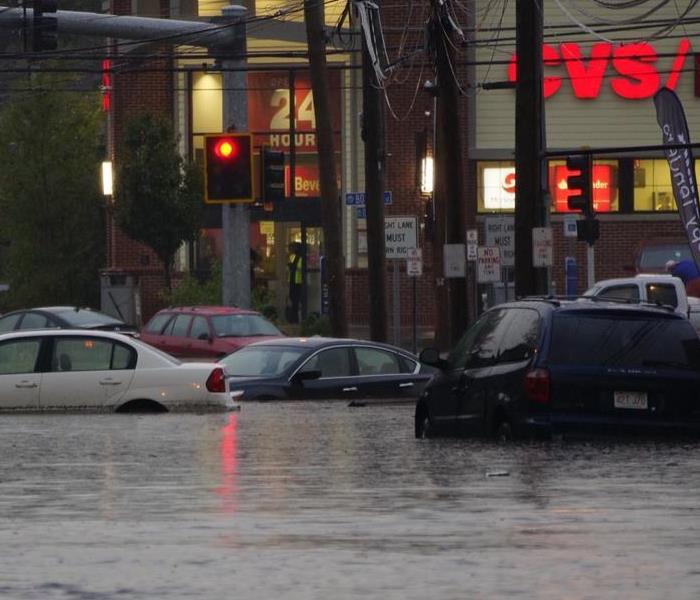 Flooding can occur with out warning despite the advanced weather technology. Having a plan and knowing how to react makes all the difference.
Flooding can occur with out warning despite the advanced weather technology. Having a plan and knowing how to react makes all the difference.
So you got flooded.. Now what do you do
Everyone always wants to get back to normal as soon as possible, with as little cost and intrusion into their life as possible. Guess what??? That expectation is the worst way to approach this kind of water loss. While it sounds great what is the big deal. Let us explore the things that can happen when you actually move too quickly.
Having anything submerged in water means it was able to saturate. Saturated clothing can be wrung out but is still wet at the fiber level. Guess what wood does the same thing. Unlike clothing wood structures cannot be thrown into a dryer. That is right inside those beams are still wet. Behind that wall is soaked, oh your home is insulated yeah that’s wet too. That beautiful wood floor is sitting on a subfloor that space is wet too. However will you get it dry. Well if you do not have high powered fans and commercial grade dehumidifiers it can take months yes months to air dry.
Aside from the fact that everything is wet, said you were flooded right? Guess what dispite what you think flood water is not clean. At all!!!! It is flooded because the water did not have a normal place to drain. Where does most city water drain into??? That is right the sewer system.. Sooo if you are flooded because the sewer system is not working that is right folks you have been flooded with sewer water.
CHECK FIRST
- Is mold already growing
- Is electricity on & active ( Never walk through water to power off electricity)
- Check for gas leaks
- Is the structure safe
- Wear protective eye glasses, Shoes and gloves and respirator if you suspect mold.
- Do not mix chemicals the vapors can be deadly ( Especially Bleach and Vinegar)
Step by Step guide:
- Get to safety: If the rain has stopped flooding is still possible as the water drains from some areas and into others. Makes sure you stay safe. Once it is safe to do so start assessing the personal damage you have incurred.
- Insurance: Most people have home owners insurance. Guess what they do not cover flood insurance so start there. If you were flooded and do not have flood insurance you are on your own. Even if you do it is your responsibility to keep the home safe and reduce damages as much as you can. Which means you cannot wait to hear from the insurance company. Should you get mold or rot from waiting most likely it will not be covered due to the fact that it is considered secondary damage. Meaning it would not occur if you had started to clean up immediately.
The clean up: What can you do before the adjuster arrived from the insurance company.
- Take pictures of everything, before you or anyone do any work what so ever.
- Clean up areas of the house so that wall, and floor damage can be easily seen.
- There can be hidden damage, such as behind the walls so it will be reassessed as work begins.
- Reach out to government agencies for potential assistance for aid. ( Please note that a federal disaster must be declared for you to apply for this type of assistance.
- Hire an electrician to come in and assess the safety of electrical system of the home. This will tell you what is safe and not safe to turn on ( Never turn on equipment that was submerged any salvageable items could spark and become a total loss)
- Check with the local town to see if the water is safe to use or if it was adversely affected by the flood waters.
- Go through your food and make sure you throw out anything not in a metal can. Make sure you get rid of the labels and get new ones. To identify the food later. The cans must be washed if you are going to keep them . o.
- All your silverware and utensils have to be cleaned and sorted. Wood, plastic or anything no metal or ceramic needs to go
- Cut and remove walls ( Even if they do not look damaged)
- If you see a water line ..Cut the wall at a minimum of 2 feet above that line.
- Remove insulation and yes throw it away.
- Take off the base boards , they may be able to be dried and saved but at least removing them assured they are not holding in moisture.
- It is recommended anything that cannot be dry cleaned should be thrown away. This includes but is not limited to furniture, clothing, and blankets.
- Carpets must be pulled up and while the carpet may be able to be cleaned and dried the pad cannot so throw that way.. Do not re-attach the carpet before the floor it sits on is fully dry ( Yes we have to say that again) To avoid any issues make sure that you do this within 48hrs after the water goes down so that it does not have a chance to grow anything it should not be growing ( which is anything)
- Flooring: Be it if you have wood, vinyl, laminate or tile if it was submerged in flood water it really has to go.
- If you are not sure if the tile or its adhesive is asbestos get it tested.
- If it is a painted surface and you are not sure about the presence of Lead that too should be tested.
- This step while will be a bit of a delay keeps you, your family and the workers safe.
- Subfloors: Guess what your floors sit on a floor and regardless of what sort of main floor you have most of the time the subfloor is plywood and will be affected by the water. The top floor must be removed so that this level of floor can dry fully. Make sure you do not have any buckling before you put a new floor on top once it is dry. If so you may need to replace that.
- Set up fans and Dehumidifiers to created a vortex to encourage drying. Proper fan positioning and temperature regulation will speed up the drying process.
- ****BLEACH**** DOES NOT KILL MOLD… PERIOD….
- If you see mold… There is a very specific process that must be followed. The most important step is to NOT spread the spores all over the house. So DO NOT VACCUM them unless you have a hepa-vaccum.
Contact a professional and keep in mind this is not a two or three day process. Have the right expectations going in to this. It will ease your mind and reduce the amount of stress that you have. Expecting something to be done to fast can result in long term damage that will cost more. It will also put undue stress on all involved. Take a step back and know that it could be a month or even more depending on how extensive the damage is.
Water on the rise in New England
9/14/2017 (Permalink)
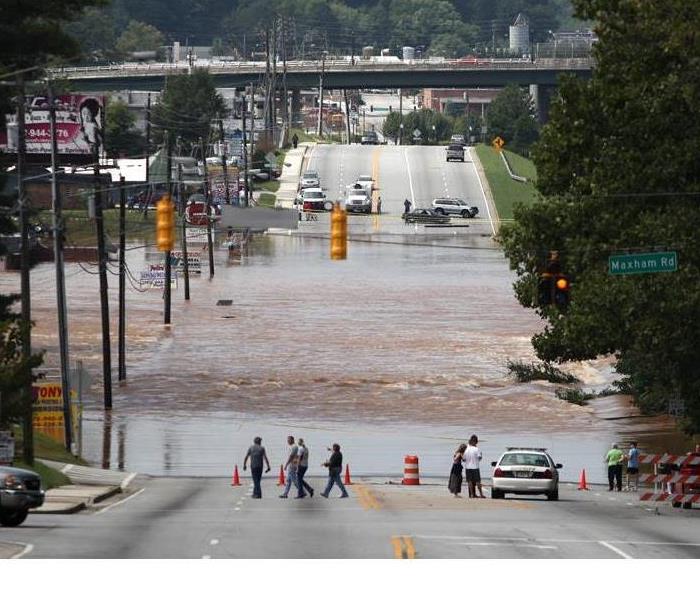 Flooding is going to become an increasing problem in and around the Boston area over the next few years. Being prepared is going to be pivotal.
Flooding is going to become an increasing problem in and around the Boston area over the next few years. Being prepared is going to be pivotal.
Massachusetts
Storms and their frequency are on the rise. In addition so too is the intensity of each event. In the United states there has been a 74% increase in the top tier precipitation events since 1958. Flood events have risen along with this severely altering the environment, wildlife, and financial obligations of cities, towns, and individual residents. With flooding of sewer systems there comes an increase of pollution to fresh drinking water access. Being prepared for these types of events is pivotal.
The areas impacted the most from these rain events has actually been the northern costal and mountainous regions of the country. Areas in Eastern Massachusetts have seen an uptick in rain event days that have more than 2 inches of rain per event. The average rainfall has also seen a 1 to 2 inch increase since the 1970’s. The major Connecticut river basin alone has seen double the heavy rain events over the last 60 years. Most of this rain has occurred from May to September.
This shift has also changed the frequency of coastal storms. The rising sea levels are changing the shape of the coast and what is actually considered the coast. We must all be prepared. These storms are what are known as hurricanes and Nor’Easters. Those alone are not the only threats. Increased intensity of Thunderstorms, tornado frequency and even damaging hail events are on the rise. The structural damage that is caused to homes, cars and the natural environment around you can be catastrophic.
Key findings on a recent survey stated that sea level rising by 2030 is estimated to rise by another 8 inches. These higher water levels also mean stronger waves as well as farther reaching damage. While there is protection from areas like Winthrop, Hull and Harbor Islands this is not a guarantee of safety. These sea level rises coupled with the increased intensity of storm level events the sewer systems can be quickly overloaded. River flooding and their overflow channels will be overwhelmed and run off into streets, yards, homes and fields.
What scientists call the 100 Year flood is now being seen every 60 years or so. By the year 2050 these flood level events will be every 10-20 years. In Boston alone these 100 year flooding events are projected to recur every 1-2 years. For many subsets of Boston such as East Boston which are built up and used to be the harbor flooding is a serious concern. Costal Massachusetts is at high risk due to the rising rain fall and sea levels. We are already seeing an uptick in claims and severity of the claims. If you are not currently in a sanctioned flood zone yet, get flood insurance now. This will grandfather you into the policy. Should your area reclassified you will not have to pay new premiums on rates for the new requirements.
Please be aware and be prepared for these events. Check out our preparedness plans for what to have ready and on hand now so you can be safe later.
Water Energy technology ...
7/21/2017 (Permalink)
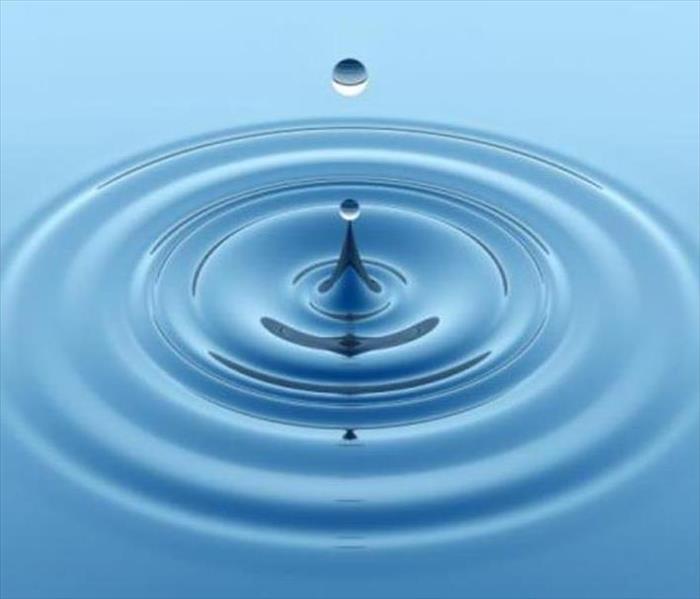 Water is beautiful, powerful, and can be destructive. Harnessing that power can be the difference between water damage and water energy
Water is beautiful, powerful, and can be destructive. Harnessing that power can be the difference between water damage and water energy
This link for ways to harness energy could be just the thing we need to increase renewable energy resources.
In turn through a better harness of the energy could we reduce the damage it causes when we have an influx. While these questions may be a long way off the technology is there. That is a start of new beginnings. Energy.gov shares wonderful news about technological advances so check back often.
https://energy.gov/eere/articles/5-promising-water-power-technologies
The world’s first hydroelectric power plant, located along the Fox River in Appleton, Wisconsin, started illuminating the home of plant-builder H.J. Roger and a nearby building on Sept. 30, 1882. Afterward, and for the next hundred years, hydropower plants grew in size and number. Today more than 2,000 hydropower plants generate clean, reliable energy across America.
But for water power to realize its full potential, innovative technologies are needed to meet new challenges and harness new resource types, from streams to the ocean. Below are five promising water power technologies under research now:
5 Promising Water TechnologiesWater InfographicModular hydropower
While existing hydropower is among the least expensive sources of electricity, building a new plant can be expensive. Modern technologies are needed to reduce installation and civil works costs. One potential answer is modular hydropower, which uses separate, similar components that can be constructed off-site then easily integrated into new or existing sites and scaled to greater capacities.
Modular hydropower systems for non-powered dams and other untapped sites can lower construction costs and reduce environmental impacts. For example, a 24-foot long and 16-foot high prototype dam, composed of six precast blocks, was built in Massachusetts as part of the HydroNext Initative in order to lower cost, improve performance, and promote environmental stewardship of hydropower development.
Powering non-powered dams
Today hydropower is the largest renewable energy source in the U.S. Still, tens of thousands of dams across the country don’t produce power. Adding generation equipment to these sites could add up to 12 GW of new hydropower capacity to the grid, and using existing dam infrastructure can lower construction costs and reduce permitting time—meaning hydropower is added to the grid faster. Because 49% of hydropower capacity is owned by the U.S. Government, federal dams represent a big opportunity to develop non-powered dams.
Pumped-storage hydropower
Pumped-storage hydropower (PSH) works like a big battery. It pumps water to a higher elevation, which can then be released at any time to turn turbines and meet energy demand. As the largest form of utility-scale energy storage, PSH helps stabilize America’s power grid. It can respond quickly to grid instability or power outages and balance variable generation, such as from wind and solar. The country’s 42 PSH plants help make the electric grid reliable and resilient, but Energy Department-funded research shows we can add even larger amounts of new, flexible, low-cost PSH.
Tidal energy
Tides occur worldwide, but making electricity out of them requires a 16-foot difference between low and high tides. While there are no permanent tidal power plants in the United States yet, conditions are good for tidal power generation in the Pacific Northwest and the Atlantic Northeast regions. The Energy Department has funded research to develop new ways to install, maintain, and decommission tidal power plants. Recently, the Energy Department continued funding for Verdant Power, Inc. to optimize a way to deploy and retrieve three tidal turbines together as a single system with one on-water operation without diver support.
Wave Energy
Ocean waves pack immense energy. The challenge for scientists—and a focus of the Energy Department—is developing technology that can safely, reliably, and cost-effectively convert wave energy into usable electricity. But once that’s done, the potential for wave energy to supply power to major cities and distributed applications—like naval bases, desalination plants, and subsea data centers—is high. To address this challenge, the Energy Department-funded the Wave Energy Prize, an 18-month public competition, that ended with prize winner AquaHarmonics demonstrating a five-fold increase in the energy capture potential of their MHK device—which the two-person team built in a garage.
Water Damage more than meets the Eye
4/4/2017 (Permalink)
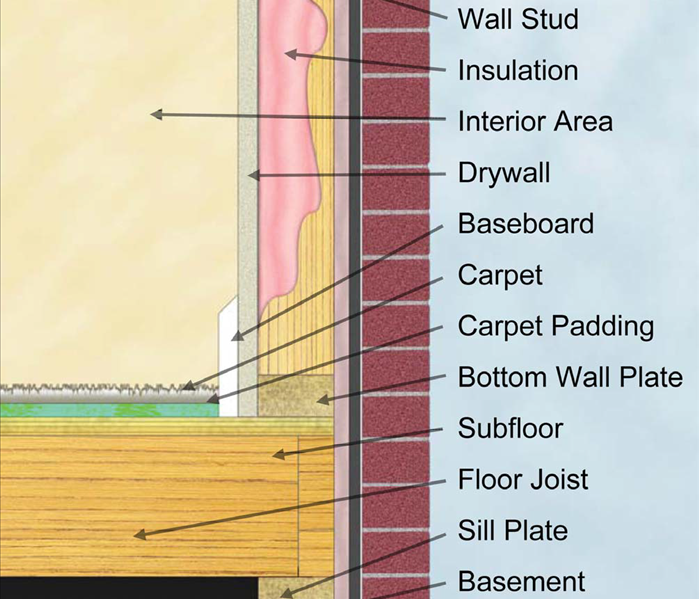 There a lot of layers behind a wall.. When your home gets flooded are you sure you dried it all out.
There a lot of layers behind a wall.. When your home gets flooded are you sure you dried it all out.
Your home should be your place of rest. When water begins leaking – even small leaks in areas you can’t see inside your home could quickly become a source of stress. The possibility of harmful mold, rot and unseen damage may affect the value of your home and the health of loved ones. Professionals understand how disruptive water damages can be for your entire family and will help ensure the water is identified, regardless of where it hides. That’s why we offer 24-hour
emergency response by trained, uniformed restoration professionals. With top-of-the line equipment and time-tested cleanup and restoration techniques, and have the expertise to help make your house feel like home again.
After all, when it comes to your home and family even a small disaster can feel like a huge problem. So if water damage occurs in your home just call a professional and get the job done right the first time.
The professionals you call should be able offer the following. Please keep in mind these professionals while adept at water damage and clean up they are not plumbers and cannot fix the underlying cause of the water.
Identify the Source/Type of Water.
Measure Temperature and Humidity for Drying Analysis.
Survey the Extent of Damage and Inspect the Premises For Hidden Moisture.
Perform Emergency Water Extraction.
Move and Block Furniture and Contents.
Inspect Carpet Pad/Carpet and Provide Service.
Apply Necessary Treatments (Disinfectants/Deodorization).
Utilize Advanced Drying and Monitoring Equipment.
Dispose of Refuse.
Water damage that you do not see is the most worrisome to us. People are always looking to save money and we get that. This results in attempts to clean up water damage themselves. Not only is this a bad idea it can be dangerous.
Water backup is from improper drainage to the sewer lines on the streets. Think about that for a moment. ..Sewer line back up, Contamination bacteria and a host of other hidden potentials. The other problem with this self clean up all too often people forget about what you cannot see. For example water comes in through the home, passes through your wall to get into your home. What is in your wall that you do not see? Insullation, Drywall, electrical wiring, maybe even insects and animal dropping or carcasses can all be behind there. When dirty water passes through there a lot that can go wrong, especially when you do not know it is even there.
Water restoration companies have special equipment that allows them to determine how wet certain materials are behind the scenes. They also have the training to understand water migration and that what is not always visible can still be there. Special training and equipment allows them to know to pull off baseboards, proper angle of fans in conjunction with industrial styled dehumidifiers to properly push the water out from behind walls into the air and extract it directly out of the air. There is a lot more to water remediation than getting it off the floor. You must then have the proper cleaners and anti-microbial sprays to rid the surfaces of all the bacteria and contaminants the water touched.
Please make sure you reach out to your local remediation company whenever you have water intruding into your home so that you can get back to normal as quickly and safely as possible.
Tips to help prevent freezing pipes
9/29/2016 (Permalink)
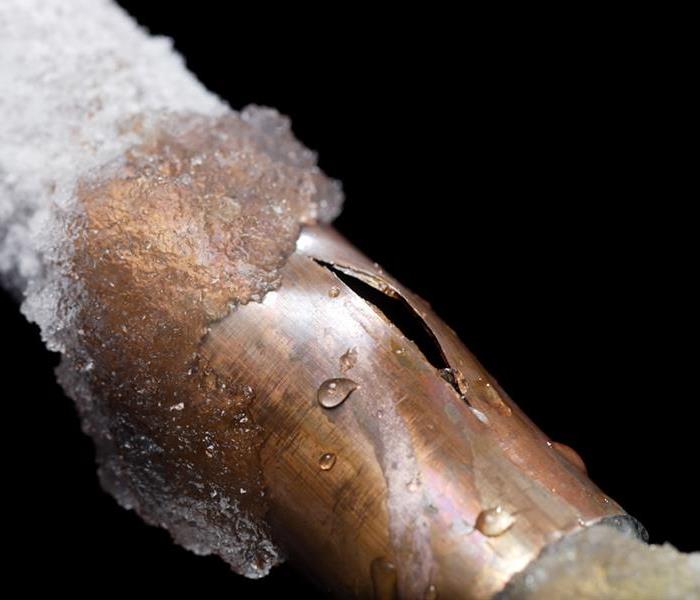 A tiny break like this can cause thousands of dollars of damage. Especially if you are away when it happens.
A tiny break like this can cause thousands of dollars of damage. Especially if you are away when it happens.
Accuweather is predicting a long winter with cold and snowy conditions late into the spring of 2017. They are even warning the citrus crops will be in danger. Now is the time to prepare yourself and your home for this forecast. Being prepared can mean the difference between turning on your water and having your water turn on you.
There are many cases the pipe insulation is not worth it, the time and effort is not worth it. You must consider the value beyond the initial dollar. If you forgo this step and we have excessive cold they have an increased chance of freezing and bursting. A broken pipe can cause 10’s of thousands of dollars worth of damage. The time effort and stress can be overwhelming.
Pipes freezing and breaking is our number one call is the winter. While we are always here to help with any water damage you may incur, ideally we would like to show you how to help prevent it. This is not a very difficult project nor is it overly time consuming. It can also serve two purpose one to keep your pipes from freezing and two will hold in the heat better and reduce energy consumption by 3 to 4% a year. Every little bit helps.
How to protect from pipes freezing this winter.
Select the best wrap for the job. Polyethylene or neoprene foams or fiberglass tend to be the easiest and most cost effective. This will typically cost 10-15 for a smaller home and go up a little based on the size of the house. You must look at the size and length of the pipes that you will be covering. Please note if choosing the fiberglass option gloves are advised. When working with the pipes make sure you stay at least 6 to 8 inches away from the flue. Place the insulation seam side down and secure with duct tape or wire. That is pretty much it.
Be safe Be Prepared……
Water quality can change quickly
8/17/2016 (Permalink)
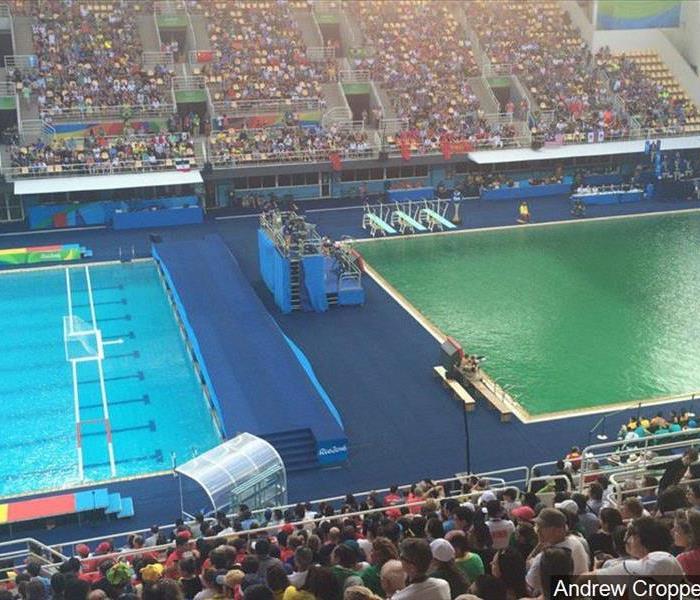 Water quality and safety can change in the matter of one day. Improper knowledge of chemical mixures and their effect is pivotal.
Water quality and safety can change in the matter of one day. Improper knowledge of chemical mixures and their effect is pivotal.
Water with chemical imbalances can be a huge problem just ask the Rio Olympic committee. The first week of the Olympics two of the pools turns a mucky colored green and then began to smell up the arena. This is a huge problem for the athletes that were competing because the algae bloom could cause potential health risks along with affecting their ability to perform. Synchronized swimming for example relies on all members of a team being able to see each other underwater, impossible to do with unclear water.
The main issue was, not understanding how various chemical combinations affect one another. Chlorine was originally used in the pools which is a great way to neutralize algae. The testing for the proper levels was conducted and all showed they were being maintained at proper levels. Introduce here the hydrogen peroxide, and before you say it yes you can uses hydrogen peroxide to maintain a pool. The problem lies in the combination of the two. Hydrogen peroxide neutralizes the effect of the chlorine. That leaves room for algae to thrive and created the problem.
Understanding basic chemicals and the effect when combined with others can not only save you a lot of work could potentially save your life. Chemicals do not always mean man made either. Something seemingly innocuous as vinegar can be deadly if combined with bleach the fumes can kill you. Ammonia and bleach can result in very similar gases and even produce chemical burns if inhaled. Did you know rubbing alcohol and bleach can damage your nervous system eyes liver and more?
Those are just a few examples there are even examples of chemicals that are found within the foods that we eat that when combined can be dangerous. Energy drinks for example when combined with milk can cause vomiting and severe stomach aches. Milk will also even reduce the effectiveness of antibiotics on your system. Grapefruits interact with many medications resulting in death. When on blood thinners many vitamin K enriched foods can alter the way that they work. WE are not doctors nor do we pretend to be. Always discuss any changed with a professional and if you are ever questioning how you feel seek help immediately.
It is important to question any chemical mixture before you do so. It is pivotal to keeping you safe. Dirty water in your home can change just as quickly with the absence or presence of just one speck of bacteria or one wrong chemical introduction. Please make sure if you ever have a question a professional is called and consulted.
Water damage, Ice Dams and Gutter Cleaning ?????
5/18/2016 (Permalink)
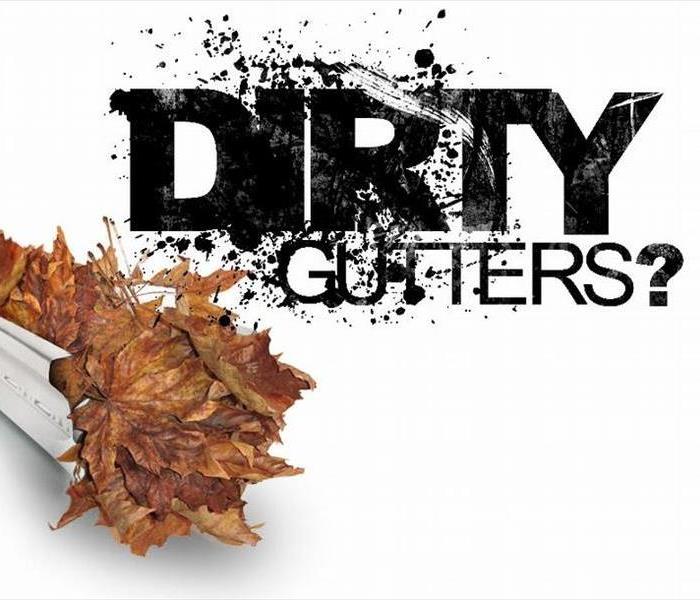 Cleaning your gutters helps prevent water damage
Cleaning your gutters helps prevent water damage
Water damage, ice dams, leaking roofs, and insect and animal infestations, and mold.. you may be wondering why we are talking about ice dams, water damage, and such in the spring, Well let me explain. Most ice dams are caused by issues with the roof, ventilation and insulation issues. That being said making sure that the water stays away from the wrong areas of your home is pivotal.
Gutters that are free and clear of debris will do just that. When there is debris in the spring summer and fall sure the water will back up and many times overflow and follow the path of least resistance. When there is no freezing going on. It can push up onto the roof overflow the gutter and spill down the side of the home and along the edges of the house. A gutter that is full of debris can make a great home for rodents and insects. Now you may be thinking no big deal. Let us look at that a bit more.
We live in New England and freezing temperatures and melting ice and snow are inevitable. With that comes the problems. Ice and snow melt and too follow the path of least resistance. This becomes especially problematic when it moves further away from the heat source and refreezes. Because when it gets under shingles, in-between the framing, and in any crevice that it wants it enlarges and can create holes. These holes will allow more heat to escape and a larger path for the water to travel through. The warmth from the hole will attract the insects and animals that are living in you gutter and can become large enough for them to enter. If it is not the may be willing to make it larger. As you can see an endless cycle.
Having your gutters cleaned regularly in the spring and again in the fall after the leaves have fallen will make sure water has a clear safe place to travel. While this may not prevent every ice dam from forming it will certainly help keep water where it should be. Prevention is the far less costly than repairs.
Should you notice any funny odors, holes, or bee hives on an edging of your home call a professional to have it inspected so that you can fix the problem before it gets worse.
Water and Sewage Backup
3/30/2016 (Permalink)
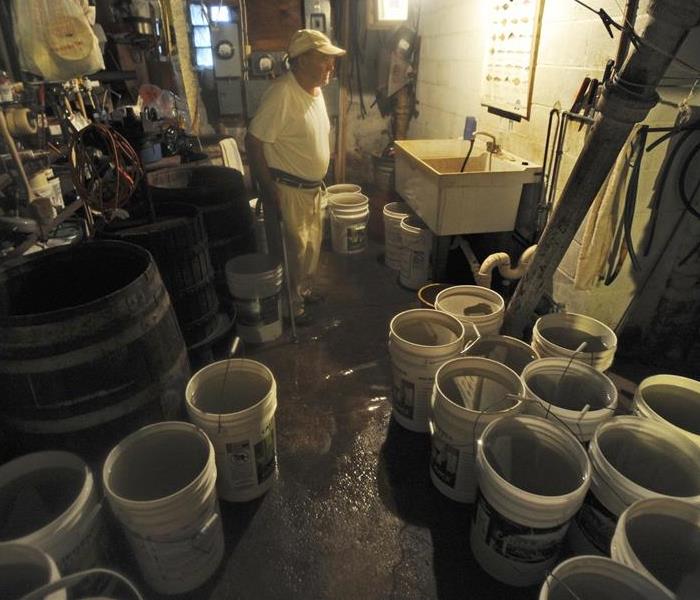 Image of water seeping into a basement
Image of water seeping into a basement
Water and Sewage Backup
There are 3 Categories of water damage..how dirty is your problem…..When you have a water damage in your home it is good to know how severe your problem is. No matter if the water damage is in your basement, from a washing machine overflowing, in your kitchen because your dish washer line let go while you were at work, or in the bathroom because the football team visited and your toilet overflowed and cannot handle 15 teenage boys. The type of water that is all over your home makes a huge difference.
Clean water -Broken pipe, leaky faucet
Gray water- dishwasher, Urine w no fecal matter, Washing machine
This water can quickly turn into stage 3 if not handled quickly.
Black water- Standing water overflow w fecal matter, Flooding waters
Note: Sewage back up should be handled immediately and considered an emergency since the water may contain viruses’ bacteria and other microbes that can cause serious illness. The severity of the health threat is going to depend on the source of the water and the extent of penetration into the home or business. How the water enters the area and the materials that are affected along with the time that the water sits will have an impact on extent of the damage is. Even floodwater or storm water which has not been directly impacted by sewage discharges is likely to contain a wide variety of microbiological organisms (e.g., from animal wastes, street runoff, etc.) and must be properly managed. Some of these pathogens, such as mold spores, can even establish themselves long after the water has receded.
Obviously the ideal thing to prevent the problem but that is not always feasible and sometimes being pro-active and taking quick action are paramount. Mitigating the risk of infection is important to keep you and your family healthy.
Prevention:
If a home is located in an area subject to periodic flooding (such as in a floodplain) or where sewage backups have occurred, the homeowner should implement "all feasible measures" to prevent/minimize the nature and extent of impacts from such situations. Such actions can be preventive or pro-active.
Preventive actions include:
1. waterproofing the building foundation and/or sealing cracks in foundation floor or walls;
2. installation of a check valve or shut-off valve on the building sewer close to where it enters the structure, which will protect your home from sewage back-ups due to surcharging conditions in the municipal sewerage system (you must check with the proper sewer authority prior to taking this action!!); and
3. raising or removing any sink, toilet, washing machine, etc. in the basement that may be subject to backups when the sewer system surcharges.
Pro-active measures include:
1. purchasing or installing a pump (e.g. sump pump) to pump out water that collects in the low point of the basement or structure;
2. ensure that building gutter downspouts and drains are directed away from the foundation and toward low points away from the home;
3. to the extent possible, keep furniture and valuables above flood levels where flooding has previously occurred; and
4. if minor flooding occurs, follow the water to its point-of-entry and seal cracks or defects to the extent possible.
Remember, an ounce of prevention is worth more than a pound of cure. Flood insurance is also vitally important where properties are known to be in floodplains or flood prone areas. More information on prevention and flood insurance is available on the FEMA website.
Cleanup of Internal Areas
Once the flood waters have receded and the property can be accessed safely, cleanup operations should commence -Remember to check with local emergency management officials before returning to a property affected by flooding! The most important steps are to restore the environment to a dry state and salvage any valuable property. The longer that water/waste are allowed to remain in your home or on your property, the greater the potential for illness and irreparable damage to your home, its contents, and environs. Where they may be operated safely, use of pumps and dehumidifiers will be helpful in restoring dry conditions. In any flood cleanup project regardless of the source,one should assume that pathogens are present and take appropriate precautions.
The survival of pathogens depends on a number of factors: location (indoors vs. outdoors), season, type of surface contaminated, whether disinfectants are used, and also on environmental conditions such as humidity, temperature, and sunlight. Sunlight (UV radiation) reduces the survival rate of pathogens with numbers decreasing rapidly with increasing exposure to UV radiation. Mild temperatures and higher humidity in external situations result in longer survival times.
As always when there is water damage assess the level of intrusion, type of water, and make sure when in doubt you call a professional there is a lot at stake, because at SERVPRO family matters. The guidance of experienced professionals and public health officials who are able to view a home and assess the needs of your particular situation can make all the difference
5 Causes of water damage in the home:
3/22/2016 (Permalink)
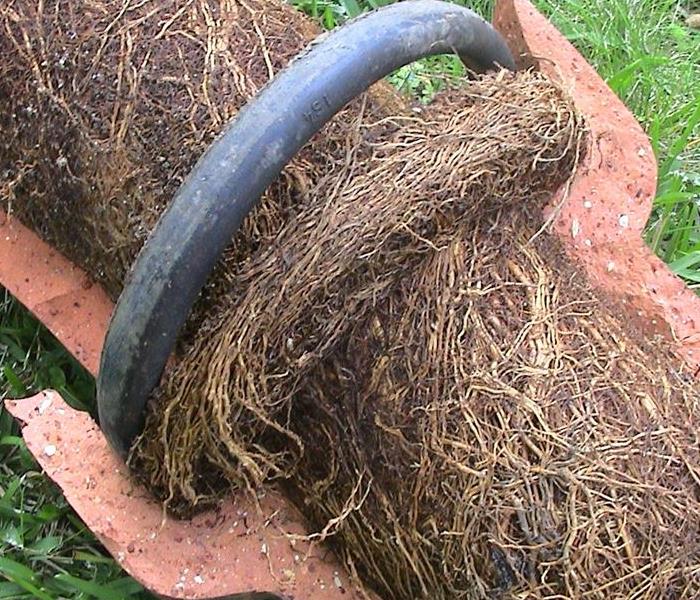 Roots in pipes cause major problems
Roots in pipes cause major problems
Water will not damage my home I am careful, I do not live in a cold climate my pipes will not burst. Let us examine that claim. Do you have kids, Washing machines, dish washers, Ice makers in your refrigerator, air conditioners, tress on your property, an older home or gutters then you are at risk.
Kids love things they do not understand and they love to try and figure it out with their hands if possible. Water is exceptionally fascinating especially since a great deal of time is spent trying to teach them how to use a toilet and have a sense of personal hygiene. That being said the drains in the sink, bathtub and toilet are an immediate fascination. Watching what happens as water swirls around and slips down into the abyss of the drain. What is even more fascinating is watching what happens as it bubbles up over the rim and begins to flow all over the bathroom. Kids will put many things into a toilet to force it to overflow. Drains will be clogged with all sorts of toys backing up the pipes forcing flooding the bathroom.
New technologies such as ice makers, dish washers and air conditioners have made our lives very convenient. Constant temperatures to keep us comfortable and ice when we want it for our favorite beverages and a hands free time free way to clean it all up allows us the finer things. There is a price to be paid for these luxuries.
Sometimes they fail resulting in flooded homes, flooded basements or water damage in the kitchen. Maintaining these appliances is crucial in making sure you check for ever small leaks as they can seep under the floor, water damage in between walls to porous materials can quickly becomes costly. New technological advances in types of hoses and piping techniques can reduce this problem inspect your home regularly and update any older hoses and piping areas to avoid massive water damage to your home.
Air Conditioning units are designed to collect water in a drain and transport it outside. If a blockage occurs your living room can soon become a serious source of water damage. These units are usually put on some sort of wooden structure which can and should be inspected frequently. Should you see your wood floors with water running over them or your carpet is saturated please call a professional as it is already too late to clean up this water damage yourself.
Trees and nature, while many of us like the convenience of the modern world we still want the beauty of the natural one. So you surrounded your property with trees, bushes, shrubs and flowers. Trees are tall, strong, and very resilient many surviving 100’s of years. This is in part to their ability to seek out food and water. The pipes are full of food and water and due to the strength we admire in the branches so to rings true for their roots. Many times trees will break through weak spots in a pipe and drink from the water and soak up the nutrients from the sewage contained within them. The roots will continue through it growing within the pipe itself thus supplying it with a constant food and water source. Roots in a pipe can be a very big problem and a great source of trouble for sewage damage and water damage in and around your home.
Gutters can also cause serious water damage to your roof and attic areas. Many times these are unchecked due to lack of consistent access to these areas of your home. When gutters get clogged with leaves, and branches the water will no longer be able to flow down and seeks an alternative path, this is usually onto and through your roof. Once it gets through your roof the water damage will invade your attic and left unnoticed or unchecked can result in mold growth.
So if you think that you would never have water damage in your home think again. Pipes bursting from the cold is not the only water damages your home. Be on the lookout and if you find something call a professional because you never know how long it has been going on.
Remember: With any kind of water damage in the home, time is of the essence! Drying the home in three days or less prevents the growth mold.
Raising Temps...mean frozen pipes melting.. Be on the look out.
2/16/2016 (Permalink)
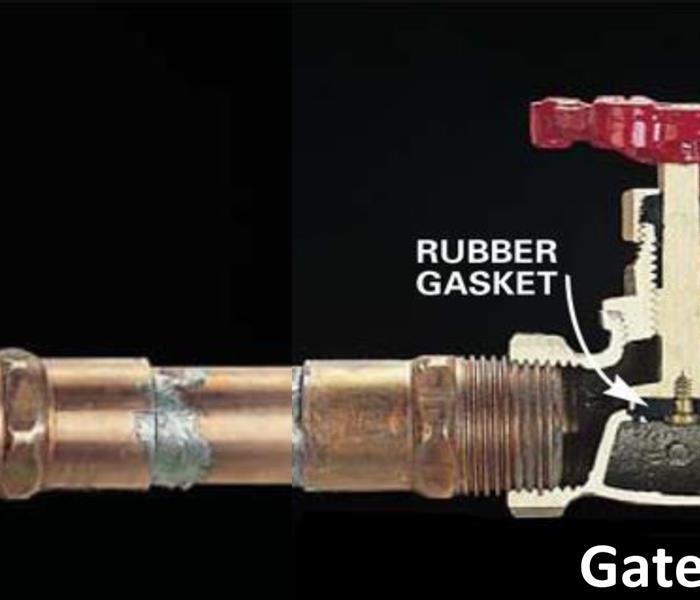 Find out where you main water shut off valve is
Find out where you main water shut off valve is
Temps are warming up.. You may have a frozen pipe and not know it. Make sure you know where your main water shut off is to mitigate damages. Find some useful tips below on what to look for.
Almost all water meters have one main shutoff valve directly before the meter and another directly after. Where the meter is located depends on the climate in your area.
In cold climates like we find in the New England area the meter and main shutoff valves are located inside, usually in a basement or other warm area to prevent freezing.
Cities and towns have their own shuts off valve for the point where the water enters your home from the main city supply that they can shut off but you can not access this. They prefer you turn your water off or on using the main valve on the house side of the meter. This valve will normally be a gate-type valve, with a round knurled handle, requiring several full clockwise rotations to turn off. In newer homes, it could be a ball valve.
In addition, most houses built today have small, localized shutoff valves called fixture supply stops installed on the supply lines leading to other utilities in within the house such as toilets, faucets, dishwashers, washing machines, and water heaters. These tend to each have their own individual shut off valve, usually a small round or oval handle that you turn clockwise two to four full turns to shut off the flow of water.
Depending on the age of the house this may only be found on a toilet if they even have that. If there are no individual item shut offs you must always shut off the main supply when doing any work what so ever. With supply valves, you can turn off the water to a single fixture while fixing or replacing that faucet.
If your plumbing system lacks supply stops, we suggest that if you ever have to install them when you shut off the main valve to repair a sink, toilet or appliance. Eventually you'll have supply stops at every fixture, remember, fixture supply stops must be easily accessible; you can't drywall or plaster over them without installing an access panel to reach them.
Supply stop problems
There are problems even with the individual fixture supply stops. Due tot Be aware of these common problems with fixture supply stops: Many water supply valves drip when turned off and then back on again after an extended period of disuse.
To fix a drippy supply valve, try gently tightening the packing nut with a wrench, or opening and shutting the valve several times until the drip stops. If a supply valve simply won't stop leaking, your only option is to replace it—which will require shutting off the main valve. In cold climates, most people remember to close the supply shutoffs for their outdoor spigots to prevent freezing, but many then forget to open the outside spigot to drain the remaining water.
If the water trapped between the spigot and supply shutoff valve freezes, it can burst that section of pipe. Since there's no water flowing through this short damaged section of pipe, there are no obvious leaks or sign of damage—yet. But when you turn the supply valve back on in the spring and pressure returns to that pipe, the burst section of pipe will leak like crazy—and often go unnoticed for hours or days. One plumber told me he's made dozens of repairs dealing with this mistake.
Finally, many icemakers and furnace humidifiers are fed by small flexible copper tubes that are connected to larger copper pipes via a very small T-handled device called a saddle valve These valves essentially bite into the larger pipe to feed the smaller one. Leaky saddle valves are a major cause of residential water damage and are no longer code-compliant in many areas. If you have saddle valves, replace them with standard supply stops.
Freezing Temps.. Freezing Pipes what you need to know
2/12/2016 (Permalink)
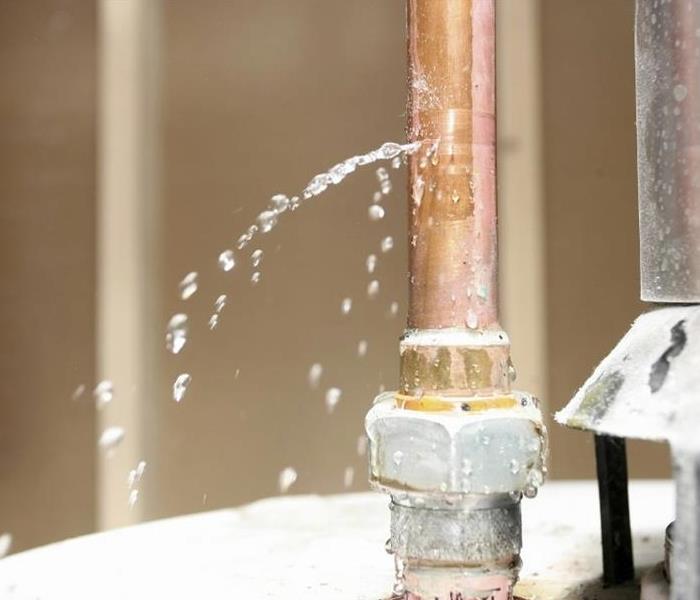 Frozen pipe
Frozen pipe
Frozen pipes are dangerous, costly and very terrifying. If you have ever lived through a burst pipe due to frozen water, you know just how damaging and devastating they can be. If you have not, follow the steps below to help prevent them. Should you have a pipe burst please make sure you call someone immediately .In as little as two days you will start to get mold growth creating an even larger issue
What causes frozen pipes?
The recent extreme cold temperatures coming in have will create an increased risk for a frozen or burst pipe. As the temperatures drop, water in your pipes starts turning to ice. The problem will be not when it is frozen but on Monday and Tuesday when the temperatures start to warm up and the ice melts and water starts to flow out of the cracks in the pipes.
Ice causes pressure and blockage. Over time, the pressure can cause a pip to burst. This ends water flow to fixtures, causes leaks and will end in a major damage not only to the pipe but to your home or office. It does not matter what the pipe is made out of the increased pressure occurs to all pipes, including plastic, copper or steel.
Even a tiny crack in your plumbing line can release more than 250 gallons of water in a single day. That much water gushing out of your plumbing system can cause significant damage and high repair costs. Any delay in remedying the situation can result in a more costly delay.
How can I prevent frozen pipes?
Open the cabinet doors under your sinks and in storage areas to allow heat from the room to circulate around un-insulated pipes.Allow a trickle of water to drip overnight; however, be careful not to run the water into a drain line that is exposed to the extreme cold because that line might freeze.Insulate all pipes in unheated areas or against un-insulated outside walls, in garages or crawl spaces.Apply heat tape or thermostat-controlled heat cables around pipes that are exposed and prone to freezing.If you are leaving for the a vacation it is very important that you make sure your heat is turned on and is set no lower than 55 degrees.What should I do if I have frozen pipes?
Sometimes, despite the best efforts, things happen. If you know or suspect you a problem with frozen pipes, here are some immediate steps to take:
Shut off the water main to reduce pressure on frozen pipes and minimize flooding if the pipes burst.If you don’t know where your water main is or have the tools to shut off the main, now would be a good time to get prepared.Do not use an open flame to thaw your pipes. If your pipe is exposed, you can try a hair dryer.If you suspect frozen pipes, contact your plumbing experts right away.If you notice slower water flow that may mean your pipes are starting to freeze, call a plumber immediately. Typically, issues like this can be resolved before any damage occurs. STAY SAFE, WARM, AND HAPPY!!!
ICE DAM..Causes..Repair..Prevention..Solutions
12/30/2015 (Permalink)
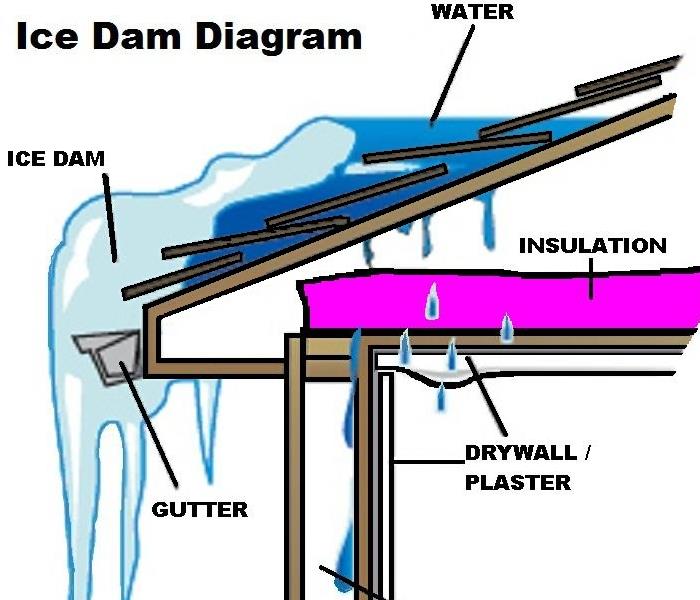 How and Ice Dam forms and the ways it can damage your home
How and Ice Dam forms and the ways it can damage your home
With Colder weather approaching Ice dams are a common problem … Have you had ice dams in the past?
How does an Ice dam form: Heat Loss from sides or roof of your home.
How can it damage my home? When you get an ice dam it can damage your home if it gets big enough…The ice that is closest to the house will start to melt and follows the path of least resistance. Many times that is under your shingles. It will continue to follow that path which can be into your insulation, down onto a ceiling or exterior walls. As it moves through maybe behind an eave it can damage the wall and the paint. The Ice Dam can break free from your home it can pull on parts of the roof, shingles or gutters. As it falls many things could be in the way. Kids playing outside, cars, shrubs, other parts of the house. If the area remains wet and not fully dry mold and rot can start to take hold.
What steps can I do stop an ice dam? There are steps that you can do to prevent an Ice dam from forming. A roof rake is a good tool for this. ( We recommend hiring a professional who uses a safety line) You have to be careful as there are really only 2 ways to use it. The first is from the roof itself pushing the snow off onto the ground. This means you have to be on a roof that has ice and snow on it. DANGEROUS>>>> The other is to keep your feet planted on the ground and pull what you can reach off of the roof. Which means you are in the path of falling snow and ice again DANGEROUS>> which again is why we recommend a professional. Replacing your roof with metal or standing seam is one way to get snow not to stick to it. While that may be expensive you could replace a smaller portion of your roof that is close to the gutters Approx. 3 ft with a drip edge. Keep in mind the incline on your roof will determine how effective or ineffective these options will be.
While all the above information will help you understand ice dams and how to work on preventing them, none of actually solve the problem of the heat loss. You have to deal with the ice dam once you have one. Let us tackle how to find out why they form to begin with and how to solve that problem.
Heat loss is how they form.. A warm roof or warmth seeping out from an unsealed edge of your home means snow has a chance to melt it will drip down to a point where it reaches the outside temperatures again and freezes again as Ice. Water follows the path of least resistance if that is down to the gutter or down into your home that escaping warmth will melt the snow and water will go to work. Should it drip down your roof it will eventually reach the colder outside air temperature. This build up over a period of time forms the ice dam. Heat loss is a very expensive problem that many do not notice until it is too late. There are many reasons for hear loss. The majority of the time it is through poor insulations or venting directly under the roof. The best solution is to work on insulation and preventing any convection through ceilings. Properly venting the space where the insulation and roof sheathing meet ensures that heat that seeps through is distributed away from the roof. Make sure you seal all living areas. A great resource is to have an energy audit with Thermograpic inspection so that you can see where the problems lie and properly seal insulate and vent in the right areas.
Obviously solving the problem is the best way to just not get an ice dam.
They do happen and when they do you have to deal with the problem. Our team at SERVPRO of East Boston Chelsea Charlestown is highly trained on dealing with the damage that an Ice dam can cause and are here for you 24/7. We will be here for you getting back to normal. Like it never even happened.





 24/7 Emergency Service
24/7 Emergency Service























